Flight and FLYING. Of the many scientific problems of modern times, there are few possessing a wider or more enduring interest than that of aerial navigation (see also Aeronautics). To fly has always been an object of ambition with man; nor will this occasion surprise when we remember the marvellous freedom enjoyed by volant as compared with non-volant animals. The subject of aviation is admittedly one of extreme difficulty. To tread upon the air (and this is what is really meant) is, at first sight, in the highest degree utopian; and yet there are thousands of living creatures which actually accomplish this feat. These creatures, however varied in form and structure, all fly according to one and the same principle; and this is a significant fact, as it tends to show that the air must be attacked in a particular way to ensure flight. It behoves us then at the outset to scrutinize very carefully the general configuration of flying animals, and in particular the size, shape and movements of their flying organs.
Flying animals differ entirely from sailing ships and from balloons, with which they are not unfrequently though erroneously compared; and a flying machine constructed upon proper principles can have nothing in common with either of those creations. The ship floats upon water and the balloon upon air; but the ship differs from the balloon, and the ship and the balloon differ from the flying creature and flying machine. The water and air, moreover, have characteristics of their own. The analogies which connect the water with the air, the ship with the balloon, and the ship and the balloon with the flying creature and flying machine are false analogies. A sailing ship is supported by the water and requires merely to be propelled; a flying creature and a flying machine constructed on the living type require to be both supported and propelled. This arises from the fact that water is much denser than air, and because water supports on its surface substances which fall through air. While water and air are both fluid media, they are to be distinguished from each other in the following particulars. Water is comparatively very heavy, inelastic and incompressible; air, on the other hand, is comparatively very light, elastic and compressible. If water be struck with violence, the recoil obtained is great when compared with the recoil obtained from air similarly treated. In water we get a maximum recoil with a minimum of displacement; in air, on the contrary, we obtain a minimum recoil with a maximum of displacement. Water and air when unconfined yield readily to pressure. They thus form movable fulcra to bodies acting upon them. In order to meet these peculiarities the travelling organs of aquatic and flying animals (whether they be feet, fins, flippers or wings) are made not of rigid but of elastic materials. The travelling organs, moreover, increase in size in proportion to the tenuity of the fluid to be acted upon. The difference in size of the travelling organs of animals becomes very marked when the land animals are contrasted with the aquatic, and the aquatic with the aerial, as in figs. 1, 2 and 3.
The peculiarities of water and air as supporting media are well illustrated by a reference to swimming, diving and flying birds. A bird when swimming extends its feet simultaneously or alternately in a backward direction, and so obtains a forward recoil. The water supports the bird, and the feet simply propel. In this case the bird is lighter than the water, and the long axis of the body is horizontal (a of fig. 4). When the bird dives, or flies under water, the long axis of the body is inclined obliquely downwards and forwards, and the bird forces itself into and beneath the water by the action of its feet, or wings, or both. In diving or sub-aquatic flight the feet strike upwards and backwards, the wings downwards and backwards (b of fig. 4). In aerial flying everything is reversed. The long axis of the bird is inclined obliquely upwards and forwards, and the wings strike, not downwards and backwards, but downwards and forwards (c of fig. 4). These changes in the direction of the long axis of the bird in swimming, diving and flying, and in the direction of the stroke of the wings in sub-aquatic and aerial flight, are due to the fact that the bird is heavier than the air and lighter than the water.
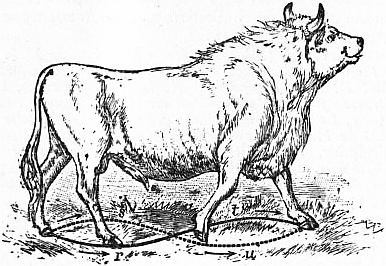 |
| Fig. 1.—Chillingham Bull (Bos Scoticus). Small travelling extremities adapted for land. r, s, t, u, figure-of-8 described by the feet in walking. |
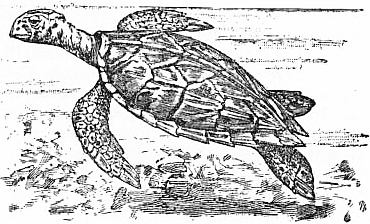 |
| Fig. 2.—The Turtle (Chelonia imbricata). Enlarged travelling extremities (flippers) adapted for water. |
 |
| Fig. 3.—The Bat (Phyllocina gracilis). Greatly expanded travelling extremities adapted for air. |
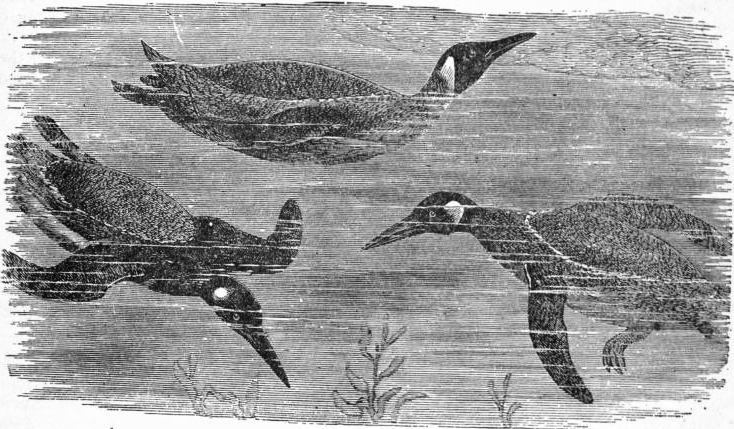 |
| Fig. 4.—The King Penguin in the positions assumed by a bird in (a) swimming, (b) diving, and (c) flying. |
The physical properties of water and air explain in a great measure how the sailing ship differs from the balloon, and how the latter differs from the flying creature and flying machine constructed on the natural type. The sailing ship is, as it were, immersed in two oceans, viz. an ocean of water and an ocean of air—the former being greatly heavier and denser than the latter. The ocean of water buoys or floats the ship, and the ocean of air, or part of it in motion, swells the sails which propel the ship. The moving air, which strikes the sails directly, strikes the hull of the vessel indirectly and forces it through the water, which, as explained, is a comparatively dense fluid. When the ship is in motion it can be steered either by the sails alone, or by the rudder alone, or by both combined. A balloon differs from a sailing ship in being immersed in only one ocean, viz. the ocean of air. It resembles the ship in floating upon the air, as the ship floats upon the water; in other words, the balloon is lighter than the air, as the ship is lighter than the water. But here all analogy ceases. The ship, in virtue of its being immersed in two fluids having different densities, can be steered and made to tack about in a horizontal plane in any given direction. This in the case of the balloon, immersed in one fluid, is impossible. The balloon in a calm can only rise and fall in a vertical line. Its horizontal movements, which ought to be the more important, are accidental movements due to air currents, and cannot be controlled; the balloon, in short, cannot be guided. One might as well attempt to steer a boat carried along by currents of water in the absence of oars, sails and wind, as to steer a balloon carried along by currents of air. The balloon has no hold upon the air, and this consequently cannot be employed as a fulcrum for regulating its course. The balloon, because of its vast size and from its being lighter than the air, is completely at the mercy of the wind. It forms an integral part, so to speak, of the wind for the time being, and the direction of the wind in every instance determines the horizontal motion of the balloon. The force required to propel a balloon against even a moderate breeze would result in its destruction. The balloon cannot be transferred with any degree of certainty from one point of the earth’s surface to another, and hence the chief danger in its employment. It may, quite as likely as not, carry its occupants out to sea. The balloon is a mere lifting machine and is in no sense to be regarded as a flying machine. It resembles the flying creature only in this, that it is immersed in the ocean of air in which it sustains itself. The mode of suspension is wholly different. The balloon floats because it is lighter than the air; the flying creature floats because it extracts from the air, by the vigorous downward action of its wings, a certain amount of upward recoil. The balloon is passive; the flying creature is active. The balloon is controlled by the wind; the flying creature controls the wind. The balloon in the absence of wind can only rise and fall in a vertical line; the flying creature can fly in a horizontal plane in any given direction. The balloon is inefficient because of its levity; the flying creature is efficient because of its weight.
Weight, however paradoxical it may appear, is necessary to flight. Everything which flies is vastly heavier than the air. The inertia of the mass of the flying creature enables it to control and direct its movements in the air. Many are of opinion that flight is a mere matter of levity and power. This is quite a mistake. No machine, however light and powerful, will ever fly whose travelling surfaces are not properly fashioned and properly applied to the air.
It was supposed at one time that the air sacs of birds contributed in some mysterious way to flight, but this is now known to be erroneous. The bats and some of the best-flying birds have no air sacs. Similar remarks are to be made of the heated air imprisoned within the bones of certain birds.1 Feathers even are not necessary to flight. Insects and bats have no feathers, and yet fly well. The only facts in natural history which appear even indirectly to countenance the flotation theory are the presence of a swimming bladder in some fishes, and the existence of membranous expansions or pseudo-wings in certain animals, such as the flying fish, flying dragon and flying squirrel. As, however, the animals referred to do not actually fly, but merely dart into the air and there sustain themselves for brief intervals, they afford no real support to the theory. The so-called floating animals are depicted at figs. 5, 6 and 7.
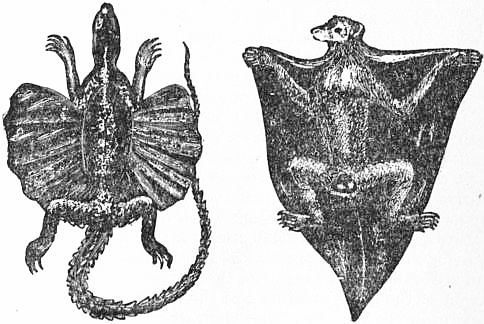 |
|
| Fig. 5.—The Red-throated Dragon (Draco haematopogon). |
Fig. 6.—The Flying Colugo (Galeopithecus volans); also called flying lemur and flying squirrel. |
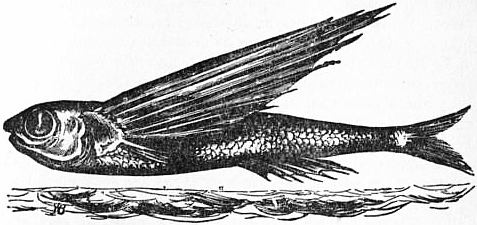 |
| Fig. 7.—The Flying Fish (Exocoetus exiliens). |
It has been asserted, and with some degree of plausibility, that a fish lighter than the water might swim, and that a bird lighter than the air might fly: it ought, however, to be borne in mind that, in point of fact, a fish lighter than the water could not hold its own if the water were in the least perturbed, and that a bird lighter than the air would be swept into space by even a moderate breeze without hope of return. Weight and power are always associated in living animals, and the fact that living animals are made heavier than the medium they are to navigate may be regarded as a conclusive argument in favour of weight being necessary alike to the swimming of the fish and the flying of the bird. It may be stated once for all that flying creatures are for the most part as heavy, bulk for bulk, as other animals, and that flight in every instance is the product, not of superior levity, but of weight and power directed upon properly constructed flying organs.
This fact is important as bearing on the construction of flying machines. It shows that a flying machine need not necessarily be a light, airy structure exposing an immoderate amount of surface. On the contrary, it favours the belief that it should be a compact and moderately heavy and powerful structure, which trusts for elevation and propulsion entirely to its flying appliances—whether actively moving wings, or screws, or aeroplanes wedged forward by screws. It should attack and subdue the air, and never give the air an opportunity of attacking or subduing it. It should smite the air intelligently and as a master, and its vigorous well-directed thrusts should in every instance elicit an upward and forward recoil. The flying machine must be multum in parvo. It must launch itself in the ocean of air, and must extract from that air, by means of its travelling surfaces—however fashioned and however applied—the recoil or resistance necessary to elevate and carry it forward. Extensive inert surfaces indeed are contra-indicated in a flying machine, as they approximate it to the balloon, which, as has been shown, cannot maintain its position in the air if there are air currents. A flying machine which could not face air currents would necessarily be a failure. To obviate this difficulty we are forced to fall back upon weight, or rather the structures and appliances which weight represents. These appliances as indicated should not be unnecessarily expanded, but when expanded they should, wherever practicable, be converted into actively moving flying surfaces, in preference to fixed or inert dead surfaces.
The question of surface is a very important one in aviation: it naturally resolves itself into one of active and passive surface. As there are active and passive surfaces in the flying animal, so there are, or should be, active and passive surfaces in the flying machine. Art should follow nature in this matter. The active surfaces in flying creatures are always greatly in excess of the passive ones, from the fact that the former virtually increase in proportion to the spaces through which they are made to travel. Nature not only distinguishes between active and passive surfaces in flying animals, but she strikes a just balance between them, and utilizes both. She regulates the surfaces to the strength and weight of the flying creature and the air currents to which the surfaces are to be exposed and upon which they are to operate. In her calculations she never forgets that her flying subjects are to control and not to be controlled by the air. As a rule she reduces the passive surfaces of the body to a minimum; she likewise reduces as far as possible the actively moving or flying surfaces. While, however, diminishing the surfaces of the flying animal as a whole, she increases as occasion demands the active or wing surfaces by wing movements, and the passive or dead surfaces by the forward motion of the body in progressive flight. She knows that if the wings are driven with sufficient rapidity they practically convert the spaces through which they move into solid bases of support; she also knows that the body in rapid flight derives support from all the air over which it passes. The manner in which the wing surfaces are increased by the wing movements will be readily understood from the accompanying illustrations of the blow-fly with its wings at rest and in motion (figs. 8 and 9). In fig. 8 the surfaces exposed by the body of the insect and the wings are, as compared with those of fig. 9, trifling. The wing would have much less purchase on fig. 8 than on fig. 9, provided the surfaces exposed by the latter were passive or dead surfaces. But they are not dead surfaces: they represent the spaces occupied by the rapidly vibrating wings, which are actively moving flying organs. As, moreover, the wings travel at a much higher speed than any wind that blows, they are superior to and control the wind; they enable the insect to dart through the wind in whatever direction it pleases.
The reader has only to imagine figs. 8 and 9 cut out in paper to realize that extensive, inert, horizontal aeroplanes2 in a flying machine would be a mistake. It is found to be so practically, as will be shown by and by. Fig. 9 so cut out would be heavier than fig. 8, and if both were exposed to a current of air, fig. 9 would be more blown about than fig. 8.
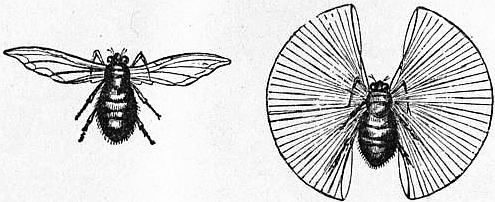 |
|
| Fig. 8.—Blow-fly (Musca vomitoria) with its wings at rest. |
Fig. 9.—Blow-fly with its wings in motion as in flight. |
It is true that in beetles and certain other insects there are the elytra or wing cases—thin, light, horny structures inclined slightly upwards—which in the act of flight are spread out and act as sustainers or gliders. The elytra, however, are comparatively long narrow structures which occupy a position in front of the wings, of which they may be regarded as forming the anterior parts. The elytra are to the delicate wings of some insects what the thick anterior margins are to stronger wings. The elytra, moreover, are not wholly passive structures. They can be moved, and the angles made by their under surfaces with the horizon adjusted. Finally, they are not essential to flight, as flight in the great majority of instances is performed without them. The elytra serve as protectors to the wings when the wings are folded upon the back of the insect, and as they are extended on either side of the body more or less horizontally when the insect is flying they contribute to flight indirectly, in virtue of their being carried forward by the body in motion.
Natural Flight.—The manner in which the wings of the insect traverse the air, so as practically to increase the basis of support, raises the whole subject of natural flight. It is necessary, therefore, at this stage to direct the attention of the reader somewhat fully to the subject of flight, as witnessed in the insect, bird and bat, a knowledge of natural flight preceding, and being in some sense indispensable to, a knowledge of artificial flight. The bodies of flying creatures are, as a rule, very strong, comparatively light and of an elongated form,—the bodies of birds being specially adapted for cleaving the air. Flying creatures, however, are less remarkable for their strength, shape and comparative levity than for the size and extraordinarily rapid and complicated movements of their wings. Prof. J. Bell Pettigrew first satisfactorily analysed those movements, and reproduced them by the aid of artificial wings. This physiologist in 18673 showed that all natural wings, whether of the insect, bird or bat, are screws structurally, and that they act as screws when they are made to vibrate, from the fact that they twist in opposite directions during the down and up strokes. He also explained that all wings act upon a common principle, and that they present oblique, kite-like surfaces to the air, through which they pass much in the same way that an oar passes through water in sculling. He further pointed out that the wings of flying creatures (contrary to received opinions, and as has been already indicated) strike downwards and forwards during the down strokes, and upwards and forwards during the up strokes. Lastly he demonstrated that the wings of flying creatures, when the bodies of said creatures are fixed, describe figure-of-8 tracks in space—the figure-of-8 tracks, when the bodies are released and advancing as in rapid flight, being opened out and converted into waved tracks.
It may be well to explain here that a claim has been set up by his admirers for the celebrated artist, architect and engineer, Leonardo da Vinci, to be regarded as the discoverer of the principles and practice of flight (see Theodore Andrea Cook, Spirals in Nature and Art, 1903). The claim is, however, unwarranted; Leonardo’s chief work on flight, bearing the title Codice sul Volo degli Uccelli e Varie Altre Materie, written in 1505, consists of a short manuscript of twenty-seven small quarto pages, with simple sketch illustrations interspersed in the text. In addition he makes occasional references to flight in his other manuscripts, which are also illustrated. In none of Leonardo’s manuscripts, however, and in none of his figures, is the slightest hint given of his having any knowledge of the spiral movements made by the wing in flight or of the spiral structure of the wing itself. It is claimed that Leonardo knew the direction of the stroke of the wing, as revealed by recent researches and proved by modern instantaneous photography. As a matter of fact, Leonardo gives a wholly inaccurate account of the direction of the stroke of the wing. He states that the wing during the down stroke strikes downwards and backwards, whereas in reality it strikes downwards and forwards. In speaking of artificial flight Leonardo says: “The wings have to row downwards and backwards to support the machine on high, so that it moves forward.” In speaking of natural flight he remarks: “If in its descent the bird rows backwards with its wings the bird will move rapidly; this happens because the wings strike the air which successively runs behind the bird to fill the void whence it comes.” There is nothing in Leonardo’s writings to show that he knew either the anatomy or physiology of the wing in the modern sense.
Pettigrew’s discovery of the figure-of-8 and waved movements made by the wing in stationary and progressive flight was confirmed some two years after it was made by Prof. E.J. Marey of Paris4 by the aid of the “sphygmograph.”5 The movements in question are now regarded as fundamental, from the fact that they are alike essential to natural and artificial flight.
The following is Pettigrew’s description of wings and wing movements published in 1867:—
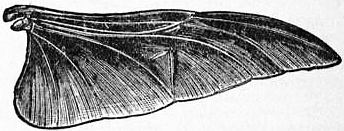 |
| Fig. 10.—Right Wing of the Beetle (Goliathus micans) when at rest; seen from above. |
 |
| Fig. 11.—Right Wing of the Beetle (Goliathus micans) when in motion; seen from behind. This figure shows how the wing twists and untwists when in action, and how it forms a true screw. |
“The wings of insects and birds are, as a rule, more or less triangular in shape, the base of the triangle being directed towards the body, its sides anteriorly and posteriorly. They are also conical on section from within outwards and from before backwards, this shape converting the pinions into delicately graduated instruments balanced with the utmost nicety to satisfy the requirements of the muscular system on the one hand and the resistance and resiliency of the air on the other. While all wings are graduated as explained, innumerable varieties occur as to their general contour, some being falcated or scythe-like, others oblong, others rounded or circular, some lanceolate and some linear. The wings of insects may consist either of one or two pairs—the anterior or upper pair, when two are present, being in some instances greatly modified and presenting a corneous condition. They are then known as elytra, from the Gr. ἔλυτρον, a sheath. Both pairs are composed of a duplicature of the integument, or investing membrane, and are strengthened in various directions by a system of hollow, horny tubes, known to entomologists as the neurae or nervures. These nervures taper towards the extremity of the wing, and are strongest towards its root and anterior margin, where they supply the place of the arm in birds and bats. The neurae are arranged at the axis of the wing after the manner of a fan or spiral stair—the anterior one occupying a higher position than that farther back, and so of the others. As this arrangement extends also to the margins, the wings are more or less twisted upon themselves and present a certain degree of convexity on their superior or upper surface, and a corresponding concavity on their inferior or under surface,—their free edges supplying those fine curves which act with such efficacy upon the air in obtaining the maximum of resistance and the minimum of displacement. As illustrative examples of the form of wings alluded to, those of the beetle, bee and fly may be cited—the pinions in those insects acting as helices, or twisted levers, and elevating weights much greater than the area of the wings would seem to warrant” (figs. 10 and 11).... “To confer on the wings the multiplicity of movements which they require, they are supplied with double hinge or compound joints, which enable them to move not only in an upward, downward, forward and backward direction, but also at various intermediate degrees of obliquity. An insect with wings thus hinged may, as far as steadiness of body is concerned, be not inaptly compared to a compass set upon gimbals, where the universality of motion in one direction ensures comparative fixedness in another.”... “All wings obtain their leverage by presenting oblique surfaces to the air, the degree of obliquity gradually increasing in a direction from behind, forwards and downwards, during extension when the sudden or effective stroke is being given, and gradually decreasing in an opposite direction during flexion, or when the wing is being more slowly recovered preparatory to making a second stroke. The effective stroke in insects, and this holds true also of birds, is therefore delivered downwards and forwards, and not, as the majority of writers believe, vertically, or even slightly backwards.... The wing in the insect is more flattened than in the bird; and advantage is taken on some occasions of this circumstance, particularly in heavy-bodied, small-winged, quick-flying insects, to reverse the pinion more or less completely during the down and up strokes.”... “This is effected in the following manner. The posterior margin of the wing is made to rotate, during the down stroke, in a direction from above downwards and from behind forwards—the anterior margin travelling in an opposite direction and reciprocating. The wing may thus be said to attack the air by a screwing movement from above. During the up or return stroke, on the other hand, the posterior margin rotates in a direction from below upwards and from before backwards, so that by a similar but reverse screwing motion the pinion attacks the air from beneath.”... “A figure-of-8, compressed laterally and placed obliquely with its long axis running from left to right of the spectator, represents the movements in question. The down and up strokes, as will be seen from this account, cross each other, the wing smiting the air during its descent from above, as in the bird and bat, and during its ascent from below as in the flying fish and boy’s kite” (fig. 12).
 |
| Fig. 12 shows the figure-of-8 made by the margins of the wing in extension (continuous line), and flexion (dotted line). As the tip of the wing is mid-way between its margins, a line between the continuous and dotted lines gives the figure-of-8 made by the tip. The arrows indicate the reversal of the planes of the wing, and show how the down and up strokes cross each other. |
... “The figure-of-8 action of the wing explains how an insect or bird may fix itself in the air, the backward and forward reciprocating action of the pinion affording support, but no propulsion. In these instances the backward and forward strokes are made to counterbalance each other. Although the figure-of-8 represents with considerable fidelity the twisting of the wing upon its axis during extension and flexion, when the insect is playing its wings before an object, or still better when it is artificially fixed, it is otherwise when the down stroke is added and the insect is fairly on the wing and progressing rapidly. In this case the wing, in virtue of its being carried forward by the body in motion, describes an undulating or spiral course, as shown in fig. 13.”
... “The down and up strokes are compound movements—the termination of the down stroke embracing the beginning of the up stroke, and the termination of the up stroke including the beginning of the down stroke. This is necessary in order that the down and up strokes may glide into each other in such a manner as to prevent jerking and unnecessary retardation.”6...
 |
| Fig. 13.—Wave track made by the wing in progressive flight. a, b, Crests of the wave; c, d, e, up strokes; x, x, down strokes; f, point corresponding to the anterior margin of the wing, and forming a centre for the downward rotation of the wing (a, g); g, point corresponding to the posterior margin of the wing, and forming a centre for the upward rotation of the wing (d, f). |
 |
| Fig. 14.—a, b, line along which the wing travels during extension and flexion. The arrows indicate the direction in which the wing is spread out in extension and closed or folded in flexion. |
 |
| Fig. 15.—Right Wing of the Red-legged Partridge (Perdix rubra). Dorsal aspect as seen from above. |
 |
| Fig. 16.—Right Wing of the Red-legged Partridge (Perdix rubra). Dorsal and ventral aspects as seen from behind; showing auger-like conformation of wing. Compare with figs. 11 and 18. |
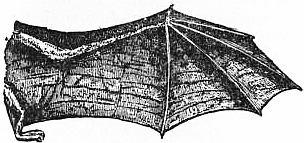 |
| Fig. 17.—Right Wing of the Bat (Phyllocina gracilis). Dorsal aspect as seen from above. |
 |
| Fig. 18.—Right Wing of the Bat (Phyllocina gracilis). Dorsal and ventral aspects, as seen from behind. These show the screw-like configuration of the wing, and also how the wing twists and untwists during its action. |
“The wing of the bird, like that of the insect, is concavo-convex, and more or less twisted upon itself when extended, so that the anterior or thick margin of the pinion presents a different degree of curvature to that of the posterior or thin margin. This twisting is in a great measure owing to the manner in which the bones of the wing are twisted upon themselves, and the spiral nature of their articular surfaces—the long axes of the joints always intersecting each other at right angles, and the bones of the elbow and wrist making a quarter of a turn or so during extension and the same amount during flexion. As a result of this disposition of the articular surfaces, the wing may be shot out or extended, and retracted or flexed in nearly the same plane, the bones composing the wing rotating on their axes during either movement (fig. 14). The secondary action, or the revolving of the component bones on their own axes, is of the greatest importance in the movements of the wing, as it communicates to the hand and forearm, and consequently to the primary and secondary feathers which they bear, the precise angles necessary for flight. It in fact ensures that the wing, and the curtain or fringe of the wing which the primary and secondary feathers form, shall be screwed into and down upon the wind in extension, and unscrewed or withdrawn from the wind during flexion. The wing of the bird may therefore be compared to a huge gimlet or auger, the axis of the gimlet representing the bones of the wing, the flanges or spiral thread of the gimlet the primary and secondary feathers” (figs. 15 and 16).... “From this description it will be evident that by the mere rotation of the bones of the forearm and hand the maximum and minimum of resistance is secured much in the same way that this object is attained by the alternate dipping and feathering of an oar.”... “The wing, both when at rest and when in motion, may not inaptly be compared to the blade of an ordinary screw propeller as employed in navigation. Thus the general outline of the wing corresponds closely with the outline of the propeller (figs. 11, 16 and 18), and the track described by the wing in space is twisted upon itself propeller fashion7 (figs. 12, 20, 21, 22, 23). The great velocity with which the wing is driven converts the impression or blur made by it into what is equivalent to a solid for the time being, in the same way that the spokes of a wheel in violent motion, as is well understood, more or less completely occupy the space contained within the rim or circumference of the wheel” (figs. 9, 20 and 21).
... “The wing of the bat bears a considerable resemblance to that of the insect, inasmuch as it consists of a delicate, semi-transparent, continuous membrane, supported in divers directions, particularly towards its anterior margin, by a system of osseous stays or stretchers which confer upon it the degree of rigidity requisite for flight. It is, as a rule, deeply concave on its under or ventral surface, and in this respect resembles the wing of the heavy-bodied birds. The movement of the bat’s wing in extension is a spiral one, the spiral running alternately from below upwards and forwards and from above downwards and backwards. The action of the wing of the bat, and the movements of its component bones, are essentially the same as in the bird” (figs. 17 and 18).
... “The wing strikes the air precisely as a boy’s kite would if it were jerked by its string, the only difference being that the kite is pulled forwards upon the wind by the string and the hand, whereas in the insect, bird and bat the wing is pushed forwards on the wind by the weight of the body and the power residing in the pinion itself” (fig. 19).8
 |
| Fig. 19.—The Cape Barn-owl (Strix capensis), showing the kite-like surfaces presented by the ventral aspect of the wings and body in flight. |
The figure-of-8 and kite-like action of the wing referred to lead us to explain how it happens that the wing, which in many instances is a comparatively small and delicate organ, can yet attack the air with such vigour as to extract from it the recoil necessary to elevate and propel the flying creature. The accompanying figures from one of Pettigrew’s later memoirs9 will serve to explain the rationale (figs. 20, 21, 22 and 23).
As will be seen from these figures, the wing during its vibration sweeps through a comparatively very large space. This space, as already explained, is practically a solid basis of support for the wing and for the flying animal. The wing attacks the air in such a manner as virtually to have no slip—this for two reasons. The wing reverses instantly and acts as a kite during nearly the entire down and up strokes. The angles, moreover, made by the wing with the horizon during the down and up strokes are at no two intervals the same, but (and this is a remarkable circumstance) they are always adapted to the speed at which the wing is travelling for the time being. The increase and decrease in the angles made by the wing as it hastens to and fro are due partly to the resistance offered by the air, and partly to the mechanism and mode of application of the wing to the air. The wing, during its vibrations, rotates upon two separate centres, the tip rotating round the root of the wing as an axis (short axis of wing), the posterior margin rotating around the anterior margin (long axis of wing). The wing is really eccentric in its nature, a remark which applies also to the rowing feathers of the bird’s wing. The compound rotation goes on throughout the entire down and up strokes, and is intimately associated with the power which the wing enjoys of alternately seizing and evading the air.
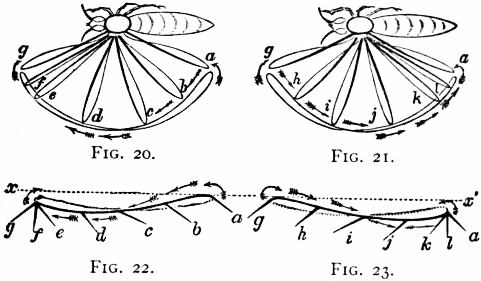 |
| Figs. 20, 21, 22 and 23 show the area mapped out by the left wing of the Wasp when the insect is fixed and the wing made to vibrate. These figures illustrate the various angles made by the wing with the horizon as it hastens to and fro, and show how the wing reverses and reciprocates, and how it twists upon itself in opposite directions, and describes a figure-of-8 track in space. Figs. 20 and 22 represent the forward or down stroke (a b c d e f g), figs. 21 and 23 the backward or up stroke (g h i j k l a). The terms forward and back strokes are here employed with reference to the head of the insect, x, x′, line to represent the horizon. If fig. 22, representing the down or forward stroke, be placed upon fig. 23, representing the up or backward stroke, it will be seen that the wing crosses its own track more or less completely at every stage of the down and up strokes. |
The compound rotation of the wing is greatly facilitated by the wing being elastic and flexible. It is this which causes the wing to twist and untwist diagonally on its long axis when it is made to vibrate. The twisting referred to is partly a vital and partly a mechanical act;—that is, it is occasioned in part by the action of the muscles and in part by the greater resistance experienced from the air by the tip and posterior margin of the wing as compared with the root and anterior margin,—the resistance experienced by the tip and posterior margin causing them to reverse always subsequently to the root and anterior margin, which has the effect of throwing the anterior and posterior margins of the wing into figure-of-8 curves, as shown at figs. 9, 11, 12, 16, 18, 20, 21, 22 and 23.
The compound rotation of the wing, as seen in the bird, is represented in fig. 24.
Not the least curious feature of the wing movements is the remarkable power which the wing possesses of making and utilizing its own currents. Thus, when the wing descends it draws after it a strong current, which, being met by the wing during its ascent, greatly increases the efficacy of the up stroke. Similarly and conversely, when the wing ascends, it creates an upward current, which, being met by the wing when it descends, powerfully contributes to the efficiency of the down stroke. This statement can be readily verified by experiment both with natural and artificial wings. Neither the up nor the down strokes are complete in themselves.
The wing to act efficiently must be driven at a certain speed, and in such a manner that the down and up strokes shall glide into each other. It is only in this way that the air can be made to pulsate, and that the rhythm of the wing and the air waves can be made to correspond. The air must be seized and let go in a certain order and at a certain speed to extract a maximum recoil. The rapidity of the wing movements is regulated by the size of the wing, small wings being driven at a very much higher speed than larger ones. The different parts of the wing, moreover, travel at different degrees of velocity—the tip and posterior margin of the wing always rushing through a much greater space, in a given time, than the root and anterior margin.
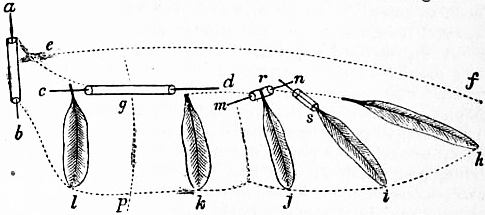 |
|
| Fig. 24.—Wing of the Bird with its root (a, b) cranked forwards. | |
a, b, Short axis of the wing (axis for tip of wing, h). c, d, Long axis (axis for posterior margin of wing, h, i, j, k, l). m, n, Short axis of rowing feathers of wing. |
r, s, Long axis of rowing feathers of wing. The rotation of the rowing feathers on their long axis (they are eccentrics) enables them to open or separate during the up, and close or come together during the down strokes. e f, g p, concave shape presented by the under surface of the wing. |
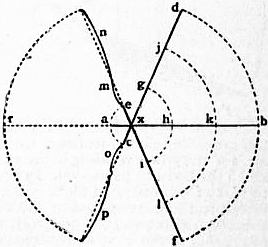 |
| Fig. 25 shows how different portions of the wing travel at different degrees of speed. In this figure the rod a, b, hinged at x, represents the wing. When the wing is made to vibrate, its several portions travel through the spaces d b f, j k l, g h i, and e a c in exactly the same interval of time. The part of the wing marked b, which corresponds with the tip, consequently travels very much more rapidly than the part marked a, which corresponds with the root. m n, o p, curves made by the wing at the end of the up and down strokes; r, position of the wing at the middle of the stroke. |
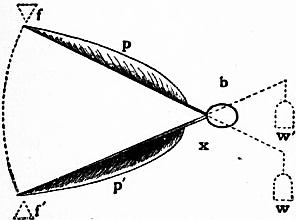 |
| Fig. 26.—In this figure f, f’ represent the movable fulcra furnished by the air, p p’ the power residing in the wing, and b the body to be moved. In order to make the problem of flight more intelligible, the lever formed by the wing is prolonged beyond the body (b), and to the root of the wing so extended the weight (w, w′) is attached; x represents the universal joint by which the wing is attached to the body. When the wing ascends as shown at p, the air (fulcrum f) resists its upward passage, and forces the body (b) or its representative (w) slightly downwards. When the wing descends as shown at p’, the air (fulcrum f′) resists its downward passage, and forces the body (b) or its representative (w′) slightly upwards. From this it follows that when the wing rises the body falls, and vice versa—the wing describing the arc of a large circle (f f′), the body (b), or the weights (w, w′) representing it, describing the arc of a small circle. |
The rapidity of travel of the insect wing is in some cases enormous. The wasp, for instance, is said to ply its wings at the rate of 110, and the common house-fly at the rate of 330 beats per second. Quick as are the vibrations of natural wings, the speed of certain parts of the wing is amazingly increased. Wings as a rule are long and narrow. As a consequence, a comparatively slow and very limited movement at the root confers great range and immense speed at the tip, the speed of each portion of the wing increasing as the root of the wing is receded from. This is explained on a principle well understood in mechanics, viz. that when a wing or rod hinged at one end is made to move in a circle, the tip or free end of the wing or rod describes a much wider circle in a given time than a portion of the wing or rod nearer the hinge (fig. 25).
One naturally inquires why the high speed of wings, and why the progressive increase of speed at their tips and posterior margins? The answer is not far to seek. If the wings were not driven at a high speed, and if they were not eccentrics made to revolve upon two separate axes, they would of necessity be large cumbrous structures; but large heavy wings would be difficult to work, and what is worse, they would (if too large), instead of controlling the air, be controlled by it, and so cease to be flying organs.
There is, however, another reason why wings should be made to vibrate at high speeds. The air, as explained, is a very light, thin, elastic medium, which yields on the slightest pressure, and unless the wings attacked it with great violence the necessary recoil or resistance could not be obtained. The atmosphere, because of its great tenuity, mobility and comparative imponderability, presents little resistance to bodies passing through it at low velocities. If, however, the speed be greatly accelerated, the action of even an ordinary cane is sufficient to elicit a recoil. This comes of the action and reaction of matter, the resistance experienced varying according to the density of the atmosphere and the shape, extent and velocity of the body acting upon it. While, therefore, scarcely any impediment is offered to the progress of an animal in motion in the air, it is often exceedingly difficult to compress the air with sufficient rapidity and energy to convert it into a suitable fulcrum for securing the necessary support and forward impetus. This arises from the fact that bodies moving in air experience a minimum of resistance and occasion a maximum of displacement. Another and very obvious difficulty is traceable to the great disparity in the weight of air as compared with any known solid, and the consequent want of buoying or sustaining power which that disparity involves. If we compare air with water we find it is nearly 1000 times lighter. To meet these peculiarities the insect, bird and bat are furnished with extensive flying surfaces in the shape of wings, which they apply with singular velocity and power to the air, as levers of the third order. In this form of lever the power is applied between the fulcrum and the weight to be raised. The power is represented by the wing, the fulcrum by the air, and the weight by the body of the flying animal. Although the third order of lever is particularly inefficient when the fulcrum is rigid and immobile, it possesses singular advantages when these conditions are reversed, that is, when the fulcrum, as happens with the air, is elastic and yielding. In this instance a very slight movement at the root of the pinion, or that end of the lever directed towards the body, is followed by an immense sweep of the extremity of the wing, where its elevating and propelling power is greatest—this arrangement ensuring that the large quantity of air necessary for support and propulsion shall be compressed under the most favourable conditions.
In this process the weight of the body performs an important part, by acting upon the inclined planes formed by the wings in the plane of progression. The power and the weight may thus be said to reciprocate, the two sitting as it were side by side and blending their peculiar influences to produce a common result, as indicated at fig. 26.
When the wings descend they elevate the body, the wings being active and the body passive; when the body descends it contributes to the elevation of the wings,10 the body being active and the wings more or less passive. It is in this way that weight forms a factor in flight, the wings and the weight of the body reciprocating and mutually assisting and relieving each other. This is an argument for employing four wings in artificial flight,—the wings being so arranged that the two which are up shall always by their fall mechanically elevate the two which are down. Such an arrangement is calculated greatly to conserve the driving power, and as a consequence, to reduce the weight.
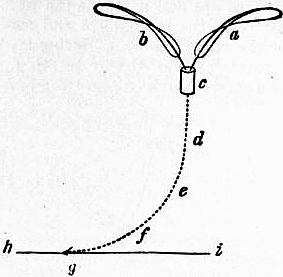 |
| Fig. 27.—a, b, quill feathers; c, cork; d, e, f, g, downward and forward curved trajectory made by the feathers and cork before reaching the ground (h, i). |
That the weight of the body plays an important part in the production of flight may be proved by a very simple experiment. If two quill feathers are fixed in an ordinary cork, and so arranged that they expand and arch above it (fig. 27), it is found that if the apparatus be dropped from a vertical height of 3 yds. it does not fall vertically downwards, but downwards and forwards in a curve, the forward travel amounting in some instances to a yard and a half. Here the cork, in falling, acts upon the feathers (which are to all intents and purposes wings), and these in turn act upon the air, in such a manner as to produce a horizontal transference.
In order to utilize the air as a means of transit, the body in motion, whether it moves in virtue of the life it possesses, or because of a force super-added, must be heavier than air. It must tread with its wings and rise upon the air as a swimmer upon the water, or as a kite upon the wind. This is necessary for the simple reason that the body must be active, the air passive. The flying body must act against gravitation, and elevate and carry itself forward at the expense of the air and of the force which resides in it, whatever that may be. If it were otherwise—if it were rescued from the law of gravitation on the one hand, and bereft of independent movement on the other, it would float about uncontrolled and uncontrollable like an ordinary balloon.
In flight one of two things is necessary. Either the wings must attack the air with great violence, or the air in rapid motion must attack the wings: either suffices. If a bird attempts to fly in a calm, the wings must be made to smite the air after the manner of a boy’s kite with great vigour and at a high speed. In this case the wings fly the bird. If, however, the bird is fairly launched in space and a stiff breeze is blowing, all that is required in many instances is to extend the wings at a slight upward angle to the horizon so that the under parts of the wings present kite-like surfaces. In these circumstances the rapidly moving air flies the bird. The flight of the albatross supplies the necessary illustration. If by any chance this magnificent bird alights upon the sea he must flap and beat the water and air with his wings with tremendous energy until he gets fairly launched. This done he extends his enormous pinions11 and sails majestically along, seldom deigning to flap his wings, the breeze doing the work for him. A familiar illustration of the same principle may be witnessed any day when children are engaged in the pastime of kite-flying. If two boys attempt to fly a kite in a calm, the one must hold up the kite and let go when the other runs. In this case the under surface of the kite is made to strike the still air. If, however, a stiff autumn breeze be blowing, it suffices if the boy who formerly ran when the kite was let go stands still. In this case the air in rapid motion strikes the under surface of the kite and forces it up. The string and the hand are to the kite what the weight of the flying creature is to the inclined planes formed by its wings.
The area of the insect, bird and bat, when the wings are fully expanded, is greater than that of any other class of animal, their weight being proportionally less. As already stated, however, it ought never to be forgotten that even the lightest insect, bird or bat is vastly heavier than the air, and that no fixed relation exists between the weight of body and expanse of wing in any of the orders. We have thus light-bodied and large-winged insects and birds, as the butterfly and heron; and others with heavy bodies and small wings, as the beetle and partridge. Similar remarks are to be made of bats. Those apparent inconsistencies in the dimensions of the body and wings are readily explained by the greater muscular development of the heavy-bodied, small-winged insects, birds and bats, and the increased power and rapidity with which the wings in them are made to oscillate. This is of the utmost importance in the science of aviation, as showing that flight may be attained by a heavy powerful animal with comparatively small wings, as well as by a lighter one with greatly enlarged wings. While, therefore, there is apparently no correspondence between the area of the wing and the animal to be raised, there is, except in the case of sailing insects, birds and bats, an unvarying relation as to the weight and number of oscillations; so that the problem of flight would seem to resolve itself into one of weight, power, velocity and small surfaces, versus buoyancy, debility, diminished speed and extensive surfaces—weight in either case being a sine qua non.
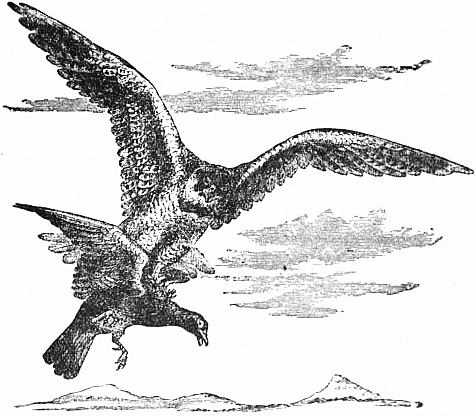 |
| Fig. 28.—Hawk and Pigeon. |
That no fixed relation exists between the area of the wings and the size and weight of the body to be elevated is evident on comparing the dimensions of the wings and bodies of the several orders of insects, bats and birds. If such comparison be made, it will be found that the pinions in some instances diminish while the bodies increase, and the converse. No practical good can therefore accrue to aviation from elaborate measurements of the wings and body of any flying thing; neither can any rule be laid down as to the extent of surface required for sustaining a given weight in the air. The statements here advanced are borne out by the fact that the wings of insects, bats and birds may be materially reduced without impairing their powers of flight. In such cases the speed with which the wings are driven is increased in the direct ratio of the mutilation. The inference to be deduced from the foregoing is plainly this, that even in large-bodied, small-winged insects and birds the wing-surface is greatly in excess, the surplus wing area supplying that degree of elevating and sustaining power which is necessary to prevent undue exertion on the part of the volant animal. In this we have a partial explanation of the buoyancy of insects, and the great lifting power possessed by birds and bats,—the bats carrying their young without inconvenience, the birds elevating surprising quantities of fish, game, carrion, &c. (fig. 28).
While as explained, no definite relation exists between the weight of a flying animal and the size of its flying surfaces, there being, as stated, heavy-bodied and small-winged insects, birds and bats, and the converse, and while, as has been shown, flight is possible within a wide range, the wings being, as a rule, in excess of what are required for the purposes of flight,—still it appears from the researches of L. de Lucy that there is a general law, to the effect that the larger the volant animal, the smaller, by comparison, are its flying surfaces. The existence of such a law is very encouraging so far as artificial flight is concerned, for it shows that the flying surfaces of a large, heavy, powerful flying machine will be comparatively small, and consequently comparatively compact and strong. This is a point of very considerable importance, as the object desiderated in a flying machine is elevating capacity.
De Lucy tabulated his results as under:—
| Insects | Birds. | ||||||
| Names. | Flying Surface referred to the Kilogramme = 2 ℔ 8 oz. 3 dwt. 2 gr. avoird. = 2 ℔ 3 oz. 4.428 dr. troy. |
Names. | Flying Surface referred to the Kilogramme. |
||||
| sq. yds. |
ft. | in. | sq. yds. |
ft. | in. | ||
| Gnat | 11 | 8 | 92 | Swallow | 1 | 1 | 104½ |
| Dragon-fly (small) | 7 | 2 | 56 | Sparrow | 0 | 5 | 142½ |
| Coccinella (Lady-bird) | 5 | 13 | 87 | Turtle-dove | 0 | 4 | 100½ |
| Dragon-fly (common) | 5 | 2 | 89 | Pigeon | 0 | 2 | 113 |
| Tipula, or Daddy-long-legs | 3 | 5 | 11 | Stork | 0 | 2 | 20 |
| Bee | 1 | 2 | 74½ | Vulture | 0 | 1 | 116 |
| Meat-fly | 1 | 3 | 54½ | Crane of Australia | 0 | 0 | 130 |
| Drone (blue) | 1 | 2 | 20 | ||||
| Cockchafer | 1 | 2 | 50 | ||||
| Lucanus cervus Stag-beetle (female) | 1 | 1 | 39½ | ||||
| Lucanus cervus Stag-beetle (male) | 0 | 8 | 33 | ||||
| Rhinoceros-beetle | 0 | 6 | 122½ | ||||
“It is easy, by the aid of this table, to follow the order, always decreasing, of the surfaces, in proportion as the winged animal increases in size and weight. Thus, in comparing the insects with one another, we find that the gnat, which weighs 460 times less than the stag-beetle, has 14 times more of surface. The lady-bird weighs 150 times less than the stag-beetle, and possesses 5 times more of surface, &c. It is the same with the birds. The sparrow weighs about 10 times less than the pigeon, and has twice as much surface. The pigeon weighs about 8 times less than the stork, and has twice as much surface. The sparrow weighs 339 times less than the Australian crane, and possesses 7 times more surface, &c. If now we compare the insects and the birds, the gradation will become even much more striking. The gnat, for example, weighs 97,000 times less than the pigeon, and has 40 times more surface; it weighs three millions of times less than the crane of Australia, and possesses 140 times more of surface than this latter, the weight of which is about 9 kilogrammes 500 grammes (25 ℔ 5 oz. 9 dwt. troy, 20 ℔ 15 oz. 2¼ dr. avoirdupois).
“The Australian crane, the heaviest bird weighed, is that which has the smallest amount of surface, for, referred to the kilogramme, it does not give us a surface of more than 899 square centimetres (139 sq. in.), that is to say, about an eleventh part of a square metre. But every one knows that these grallatorial animals are excellent birds of flight. Of all travelling birds they undertake the longest and most remote journeys. They are, in addition, the eagle excepted, the birds which elevate themselves the highest, and the flight of which is the longest maintained.”12
The way in which the natural wing rises and falls on the air, and reciprocates with the body of the flying creature, has a very obvious bearing upon artificial flight. In natural flight the body of the flying creature falls slightly forward in a curve when the wing ascends, and is slightly elevated in a curve when the wing descends. The wing and body are consequently always playing at cross purposes, the wing rising when the body is falling and vice versa. The alternate rise and fall of the body and wing of the bird are well seen when contemplating the flight of the gull from the stern of a steamboat, as the bird is following in the wake of the vessel. The complementary movements referred to are indicated at fig. 29, where the continuous waved line represents the trajectory made by the wing, and the dotted waved line that made by the body. As will be seen from this figure, the wing advances both when it rises and when it falls. It is a peculiarity of natural wings, and of artificial wings constructed on the principle of living wings, that when forcibly elevated or depressed, even in a strictly vertical direction, they inevitably dart forward. If, for instance, the wing is suddenly depressed in a vertical direction, as at a b of fig. 29, it at once darts downwards and forwards in a double curve (see continuous line of figure) to c, thus converting the vertical down stroke into a down, oblique, forward stroke. If, again, the wing be suddenly elevated in a strictly vertical direction, as at c d, the wing as certainly darts upwards and forwards in a double curve to e, thus converting the vertical up strokes into an upward, oblique, forward stroke. The same thing happens when the wing is depressed from e to f and elevated from g to h, the wing describing a waved track as at e g, g i.
 |
| Fig. 29 shows how in progressive flight the wing and the body describe waved tracks,—the crests of the waves made by the wing (a, c, e, g, i) being placed opposite the crests of the waves made by the body (1, 2, 3, 4, 5). |
There are good reasons why the wings should always be in advance of the body. A bird when flying is a body in motion; but a body in motion tends to fall not vertically downwards, but downwards and forwards. The wings consequently must be made to strike forwards and kept in advance of the body of the bird if they are to prevent the bird from falling downwards and forwards. If the wings were to strike backwards in aerial flight, the bird would turn a forward somersault.
That the wings invariably strike forwards during the down and up strokes in aerial flight is proved alike by observation and experiment. If any one watches a bird rising from the ground or the water, he cannot fail to perceive that the head and body are slightly tilted upwards, and that the wings are made to descend with great vigour in a downward and forward direction. The dead natural wing and a properly constructed artificial wing act in precisely the same way. If the wing of a gannet, just shot, be removed and made to flap in what the operator believes to be a strictly vertical downward direction, the tip of the wing, in spite of him, will dart forwards between 2 and 3 ft.—the amount of forward movement being regulated by the rapidity of the down stroke. This is a very striking experiment. The same thing happens with a properly constructed artificial wing. The down stroke with the artificial as with the natural wing is invariably converted into an oblique, downward and forward stroke. No one ever saw a bird in the air flapping its wings towards its tail. The old idea was that the wings during the down stroke pushed the body of the bird in an upward and forward direction; in reality the wings do not push but pull, and in order to pull they must always be in advance of the body to be flown. If the wings did not themselves fly forward, they could not possibly cause the body of the bird to fly forward. It is the wings which cause the bird to fly.
It only remains to be stated that the wing acts as a true kite, during both the down and the up strokes, its under concave or biting surface, in virtue of the forward travel communicated to it by the body of the flying creature, being closely applied to the air, during both its ascent and its descent. This explains how the wing furnishes a persistent buoyancy alike when it rises and when it falls (fig. 30).
 |
| Fig. 30 shows the kite-like action of the wing during the down and up strokes, how the angles made by the wing with the horizon (a, b) vary at every stage of these strokes, and how the wing evades the superimposed air during the up stroke, and seizes the nether air during the down stroke. In this figure the spaces between the double dotted lines (c g, i b) represent the down strokes, the single dotted line (h, i) representing the up stroke. The kite-like surfaces and angles made by the wing with the horizon (a, b) during the down strokes are indicated at c d e f g, j k l m,—those made during the up strokes being indicated at g h i. As the down and up strokes run into each other, and the convex surface of the wing is always directed upwards and the concave surface downwards, it follows that the upper surface of the wing evades in a great measure the upper air, while the under surface seizes the nether air. It is easy to understand from this figure how the wing always flying forwards furnishes a persistent buoyancy. |
The natural kite formed by the wing differs from the artificial kite only in this, that the former is capable of being moved in all its parts, and is more or less flexible and elastic, whereas the latter is comparatively rigid. The flexibility and elasticity of the kite formed by the natural wing are rendered necessary by the fact that the wing, as already stated, is practically hinged at its root and along its anterior margin, an arrangement which necessitates its several parts travelling at different degrees of speed, in proportion as they are removed from the axes of rotation. Thus the tip travels at a higher speed than the root, and the posterior margin than the anterior margin. This begets a twisting diagonal movement of the wing on its long axis, which, but for the elasticity referred to, would break the wing into fragments. The elasticity contributes also to the continuous play of the wing, and ensures that no two parts of it shall reverse at exactly the same instant. If the wing was inelastic, every part of it would reverse at precisely the same moment, and its vibration would be characterized by pauses or dead points at the end of the down and up strokes which would be fatal to it as a flying organ. The elastic properties of the wing are absolutely essential, when the mechanism and movements of the pinion are taken into account. A rigid wing can never be an effective flying instrument.
The kite-like surfaces referred to in natural flight are those upon which the constructors of flying machines very properly ground their hopes of ultimate success. These surfaces may be conferred on artificial wings, aeroplanes, aerial screws or similar structures; and these structures, if we may judge from what we find in nature, should be of moderate size and elastic. The power of the flying organs will be increased if they are driven at a comparatively high speed, and particularly if they are made to reverse and reciprocate, as in this case they will practically create the currents upon which they are destined to rise and advance. The angles made by the kite-like surfaces with the horizon should vary according to circumstances. They should be small when the speed is high, and vice versa. This, as stated, is true of natural wings. It should also be true of artificial wings and their analogues.
Artificial Flight.—We are now in a position to enter upon a consideration of artificial wings and wing movements, and of artificial flight and flying machines.
We begin with artificial wings. The first properly authenticated account of an artificial wing was given by G.A. Borelli in 1670. This author, distinguished alike as a physiologist, mathematician and mechanician, describes and figures a bird with artificial wings, each of which consists of a rigid rod in front and flexible feathers behind. The wings are represented as striking vertically downwards, as the annexed duplicate of Borelli’s figure shows (fig. 31).
 |
| Fig. 31. |
| Borelli’s bird with artificial wings. |
r e, Anterior margin of the right wing, consisting of a rigid rod. o a, Posterior margin of the right wing, consisting of flexible feathers. b c, Anterior; and f, Posterior margins of the left wing same as the right. d, Tail of the bird. r g, d h, Vertical direction of the down stroke of the wing. |
Borelli was of opinion that flight resulted from the application of an inclined plane, which beats the air, and which has a wedge action. He, in fact, endeavours to prove that a bird wedges itself forward upon the air by the perpendicular vibration of its wings, the wings during their action forming a wedge, the base of which (c b e) is directed towards the head of the bird, the apex (a f) being directed towards the tail (d). In the 196th proposition of his work (De motu animalium, Leiden, 1685) he states that—
“If the expanded wings of a bird suspended in the air shall strike the undisturbed air beneath it with a motion perpendicular to the horizon, the bird will fly with a transverse motion in a plane parallel with the horizon.” “If,” he adds, “the wings of the bird be expanded, and the under surfaces of the wings be struck by the air ascending perpendicularly to the horizon with such a force as shall prevent the bird gliding downwards (i.e. with a tendency to glide downwards) from falling, it will be urged in a horizontal direction.”
The same argument is restated in different words as under:—“If the air under the wings be struck by the flexible portions of the wings (flabella, literally fly flaps or small fans) with a motion perpendicular to the horizon, the sails (vela) and flexible portions of the wings (flabella) will yield in an upward direction and form a wedge, the point of which is directed towards the tail. Whether, therefore, the air strikes the wings from below, or the wings strike the air from above, the result is the same,—the posterior or flexible margins of the wings yield in an upward direction, and in so doing urge the bird in a horizontal direction.”
There are three points in Borelli’s argument to which it is necessary to draw attention: (1) the direction of the down stroke: it is stated to be vertically downwards; (2) the construction of the anterior margin of the wing: it is stated to consist of a rigid rod; (3) the function delegated to the posterior margin of the wing: it is said to yield in an upward direction during the down stroke.
With regard to the first point. It is incorrect to say the wing strikes vertically downwards, for, as already explained, the body of a flying bird is a body in motion; but as a body in motion tends to fall downwards and forwards, the wing must strike downwards and forwards in order effectually to prevent its fall. Moreover, in point of fact, all natural wings, and all artificial wings constructed on the natural type, invariably strike downwards and forwards.
With regard to the second point, viz. the supposed rigidity of the anterior margin of the wing, it is only necessary to examine the anterior margins of natural wings to be convinced that they are in every case flexible and elastic. Similar remarks apply to properly constructed artificial wings. If the anterior margins of natural and artificial wings were rigid, it would be impossible to make them vibrate smoothly and continuously. This is a matter of experiment. If a rigid rod, or a wing with a rigid anterior margin, be made to vibrate, the vibration is characterized by an unequal jerky motion, at the end of the down and up strokes, which contrasts strangely with the smooth, steady fanning movement peculiar to natural wings.
As to the third point, viz. the upward bending of the posterior margin of the wing during the down stroke, it is necessary to remark that the statement is true if it means a slight upward bending, but that it is untrue if it means an extensive upward bending.
Borelli does not state the amount of upward bending, but one of his followers, E.J. Marey, maintains that during the down stroke the wing yields until its under surface makes a backward angle with the horizon of 45°. Marey further states that during the up stroke the wing yields to a corresponding extent in an opposite direction—the posterior margin of the wing, according to him, passing through an angle of 90°, plus or minus according to circumstances, every time the wing rises and falls.
That the posterior margin of the wing yields to a slight extent during both the down and up strokes will readily be admitted, alike because of the very delicate and highly elastic properties of the posterior margins of the wing, and because of the comparatively great force employed in its propulsion; but that it does not yield to the extent stated by Marey is a matter of absolute certainty. This admits of direct proof. If any one watches the horizontal or upward flight of a large bird he will observe that the posterior or flexible margin of the wing never rises during the down stroke to a perceptible extent, so that the under surface of the wing, as a whole, never looks backwards. On the contrary, he will perceive that the under surface of the wing (during the down stroke) invariably looks forwards and forms a true kite with the horizon, the angles made by the kite varying at every part of the down stroke, as shown more particularly at c d e f g, i j k l m of fig. 30.
The authors who have adopted Borelli’s plan of artificial wing, and who have endorsed his mechanical views of the wing’s action most fully, are J. Chabrier, H.E.G. Strauss-Dürckheim and Marey. Borelli’s artificial wing, it will be remembered, consists of a rigid rod in front and a flexible sail behind. It is also made to strike vertically downwards. According to Chabrier, the wing has only one period of activity. He believes that if the wing be suddenly lowered by the depressor muscles, it is elevated solely by the reaction of the air. There is one unanswerable objection to this theory: the birds and bats, and some if not all the insects, have distinct elevator muscles, and can elevate their wings at pleasure when not flying and when, consequently, the reaction of the air is not elicited. Strauss-Dürckheim agrees with Borelli both as to the natural and the artificial wing. He is of opinion that the insect abstracts from the air by means of the inclined plane a component force (composant) which it employs to support and direct itself. In his theology of nature he describes a schematic wing as consisting of a rigid ribbing in front, and a flexible sail behind. A membrane so constructed will, according to him, be fit for flight. It will suffice if such a sail elevates and lowers itself successively. It will of its own accord dispose itself as an inclined plane, and receiving obliquely the reaction of the air, it transfers into tractile force a part of the vertical impulsion it has received. These two parts of the wing, moreover, are equally indispensable to each other.
Marey repeats Borelli and Dürckheim with very trifling modifications, so late as 1869. He describes two artificial wings, the one composed of a rigid rod and sail—the rod representing the stiff anterior margin of the wing; the sail, which is made of paper bordered with cardboard, the flexible posterior margin. The other wing consists of a rigid nervure in front and behind of thin parchment which supports fine rods of steel. He states that if the wing only elevates and depresses itself, “the resistance of the air is sufficient to produce all the other movements. In effect (according to Marey) the wing of an insect has not the power of equal resistance in every part. On the anterior margin the extended nervures make it rigid, while behind it is fine and flexible. During the vigorous depression of the wing, the nervure has the power of remaining rigid, whereas the flexible portion, being pushed in an upward direction on account of the resistance it experiences from the air, assumes an oblique position which causes the upper surface of the wing to look forwards.” The reverse of this, in Marey’s opinion, takes place during the elevation of the wing—the resistance of the air from above causing the upper surface of the wing to look backwards.... “At first,” he says, “the plane of the wing is parallel with the body of the animal. It lowers itself—the front part of the wing strongly resists, the sail which follows it being flexible yields. Carried by the ribbing (the anterior margin of the wing) which lowers itself, the sail or posterior margin of the wing being raised meanwhile by the air, which sets it straight again, the sail will take an intermediate position and incline itself about 45° plus or minus according to circumstances.... The wing continues its movements of depression inclined to the horizon; but the impulse of the air, which continues its effect, and naturally acts upon the surface which it strikes, has the power of resolving itself into two forces, a vertical and a horizontal force; the first suffices to raise the animal, the second to move it along.”13 Marey, it will be observed, reproduces Borelli’s artificial wing, and even his text, at a distance of nearly two centuries.
The artificial wing recommended by Pettigrew is a more exact imitation of nature than either of the foregoing. It is of a more or less triangular form, thick at the root and anterior margin, and thin at the tip and posterior margin. No part of it is rigid. It is, on the contrary, highly elastic and flexible throughout. It is furnished with springs at its root to contribute to its continued play, and is applied to the air by a direct piston action in such a way that it descends in a downward and forward direction during the down stroke, and ascends in an upward and forward direction during the up stroke. It elevates and propels both when it rises and falls. It, moreover, twists and untwists during its action and describes figure-of-8 and waved tracks in space, precisely as the natural wing does. The twisting is most marked at the tip and posterior margin, particularly that half of the posterior margin next the tip. The wing when in action may be divided into two portions by a line running diagonally between the tip of the wing anteriorly and the root of the wing posteriorly. The tip and posterior parts of the wing are more active than the root and anterior parts, from the fact that the tip and posterior parts (the wing is an eccentric) always travel through greater spaces, in a given time, than the root and anterior parts.
 |
|
| Fig. 32.—Elastic Spiral Wing, which twists and untwists during its action, to form a mobile helix or screw. This wing is made to vibrate by a direct piston action, and by a slight adjustment can be propelled vertically, horizontally or at any degree of obliquity. |
|
a b, Anterior margin of wing, to which the neurae or ribs are affixed. c d, Posterior margin of wing crossing anterior one. x, Ball-and-socket joint at root of wing, the wing being attached to the side of the cylinder by the socket. t, Cylinder. r r, Piston, with cross heads (w, w) and piston head (s). o o, Stuffing boxes. |
e, f, Driving chains. m, Superior elastic band, which assists in elevating the wing. n, Inferior elastic band, which antagonizes m. The alternate stretching of the superior and inferior elastic bands contributes to the continuous play of the wing, by preventing dead points at the end of the down and up strokes. The wing is free to move in a vertical and horizontal direction and at any degree of obliquity. |
The wing is so constructed that the posterior margin yields freely in a downward direction during the up stroke, while it yields comparatively little in an upward direction during the down stroke; and this is a distinguishing feature, as the wing is thus made to fold and elude the air more or less completely during the up stroke, whereas it is made to expand and seize the air with avidity during the down stroke. The oblique line referred to as running diagonally across the wing virtually divides the wing into an active and a passive part, the former elevating and propelling, the latter sustaining.
It is not possible to determine with exactitude the precise function discharged by each part of the wing, but experiment tends to show that the tip of the wing elevates, the posterior margin propels, and the root sustains.
The wing—and this is important—is driven by a direct piston action with an irregular hammer-like movement, the pinion having communicated to it a smart click at the beginning of every down stroke—the up stroke being more uniform. The following is the arrangement (fig. 32). If the artificial wing here represented (fig. 32) be compared with the natural wing as depicted at fig. 33, it will be seen that there is nothing in the one which is not virtually reproduced in the other. In addition to the foregoing, Pettigrew recommended a double elastic wing to be applied to the air like a steam-hammer, by being fixed to the head of the piston. This wing, like the single wing described, twists and untwists as it rises and falls, and possesses all the characteristics of the natural wing (fig. 34).
 |
|
| Fig. 33 shows the Spiral Elastic Wings of the Gull. Each wing forms a mobile helix or screw. | |
a b, Anterior margin of left wing. c d, Posterior margin of ditto. d g, Primary or rowing feathers of left wing. g a, Secondary feathers ditto. |
x, Root of right wing with ball-and-socket joint. l, Elbow joint. m, Wrist joint, n,o, Hand and finger joints. |
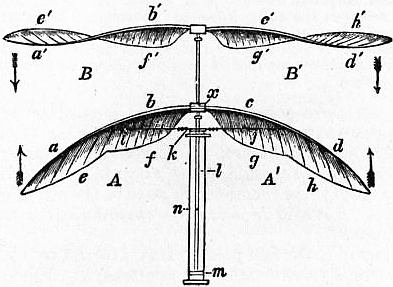 |
| Fig. 34.—Double Elastic Wing driven by direct piston action. During the up stroke of the piston the wing is very decidedly convex on its upper surface (a b c d, A A′); its under surface (e f g h, A A′) being deeply concave and inclined obliquely upwards and forwards. It thus evades, to a considerable extent, the air during the up stroke. During the down stroke of the piston the wing is flattened out in every direction, and its extremities twisted in such a manner as to form two screws, as seen at a′ b′ c′ d′, e′ f′ g′ h′, B, B′. The active area of the wing is by this arrangement considerably diminished during the up stroke, and considerably augmented during the down stroke; the wing seizing the air with greater avidity during the down than during the up stroke. i, j, k, elastic band to regulate the expansion of the wing; l, piston; m, piston head; n, cylinder. |
He also recommends an elastic aerial screw consisting of two blades, which taper and become thinner towards the tips and posterior margins. When the screw is made to rotate, the blades, because of their elasticity, assume a great variety of angles, the angles being least where the speed of the blades is greatest and vice versa. The pitch of the blades is thus regulated by the speed attained (fig. 35).
The peculiarity of Pettigrew’s wings and screws consists in their elasticity, their twisting action, and their great comparative length and narrowness. They offer little resistance to the air when they are at rest, and when in motion the speed with which they are driven is such as to ensure that the comparatively large spaces through which they travel shall practically be converted into solid bases of support.
After Pettigrew enunciated his views (1867) as to the screw configuration and elastic properties of natural wings, and more especially after his introduction of spiral, elastic artificial wings, and elastic screws, a great revolution took place in the construction of flying models. Elastic aeroplanes were advocated by D.S. Brown,14 elastic aerial screws by J. Armour,15 and elastic aeroplanes, wings and screws by Alphonse Pénaud.16
 |
|
| Fig. 35.—Elastic Aerial Screw with twisted blades resembling wings (a b c d, e f g h). | |
x, End of driving shaft. v,w, Sockets in which the roots of the blades of the screw rotate, the degree of rotation being limited by steel springs (z, s). |
a b, e f, tapering elastic rods forming anterior or thick margins of blades of screw. d c, h g, Posterior or thin elastic margins of blades of screw. The arrows m, n, o, p, q, r indicate the direction of travel. |
Pénaud’s experiments are alike interesting and instructive. He constructed models to fly by three different methods:—(a) by means of screws acting vertically upwards; (b) by aeroplanes propelled horizontally by screws; and (c) by wings which flapped in an upward and downward direction. An account of his helicoptère or screw model appeared in the Aeronaut for January 1872, but before giving a description of it, it may be well to state very briefly what is known regarding the history of the screw as applied to the air.
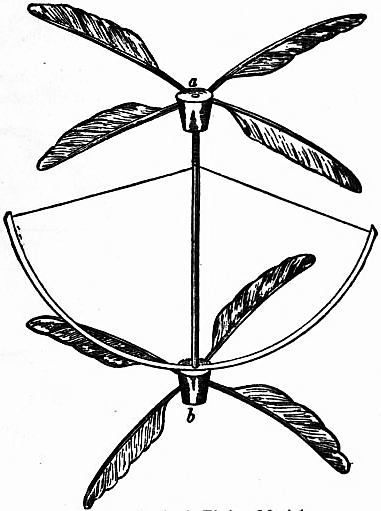 |
| Fig. 36.—Cayley’s Flying Model. |
The first suggestion on this subject was given by A.J.P. Paucton in 1768. This author, in his treatise on the Théorie de la vis d’Archimède, describes a machine provided with two screws which he calls a “ptérophores.” In 1796 Sir George Cayley gave a practical illustration of the efficacy of the screw as applied to the air by constructing a small machine, consisting of two screws made of quill feathers, a representation of which we annex (fig. 36). Sir George writes as under:—
“As it may be an amusement to some of your readers to see a machine rise in the air by mechanical means, I will conclude my present communication by describing an instrument of this kind, which any one can construct at the expense of ten minutes’ labour.
“a and b, fig. 36, are two corks, into each of which are inserted four wing feathers from any bird, so as to be slightly inclined like the sails of a windmill, but in opposite directions in each set. A round shaft is fixed in the cork a, which ends in a sharp point. At the upper part of the cork b is fixed a whalebone bow, having a small pivot hole in its centre to receive the point of the shaft. The bow is then to be strung equally on each side to the upper portion of the shaft, and the little machine is completed. Wind up the string by turning the flyers different ways, so that the spring of the bow may unwind them with their anterior edges ascending; then place the cork with the bow attached to it upon a table, and with a finger on the upper cork press strong enough to prevent the string from unwinding, and, taking it away suddenly, the instrument will rise to the ceiling.”
Cayley’s screws were peculiar, inasmuch as they were superimposed and rotated in opposite directions. He estimated that if the area of the screws was increased to 200 sq. ft., and moved by a man, they would elevate him. His interesting experiment is described at length, and the apparatus figured in Nicolson’s Journal, 1809, p. 172.
Other experimenters, such as J. Degen in 1816 and Ottoris Sarti in 1823, followed Cayley at moderate intervals, constructing flying models on the vertical screw principle. In 1842 W.H. Phillips succeeded, it is stated, in elevating a steam model by the aid of revolving fans, which according to his account flew across two fields after having attained a great altitude; and in 1859 H. Bright took out a patent for a machine to be sustained by vertical screws. In 1863 the subject of aviation by vertical screws received a fresh impulse from the experiments of Gustave de Ponton d’Amécourt, G. de la Landelle, and A. Nadar, who exhibited models driven by clock-work springs, which ascended with graduated weights a distance of from 10 to 12 ft. These models were so fragile that they usually broke in coming in contact with the ground in their descent. Their flight, moreover, was unsatisfactory, from the fact that it only lasted a few seconds.
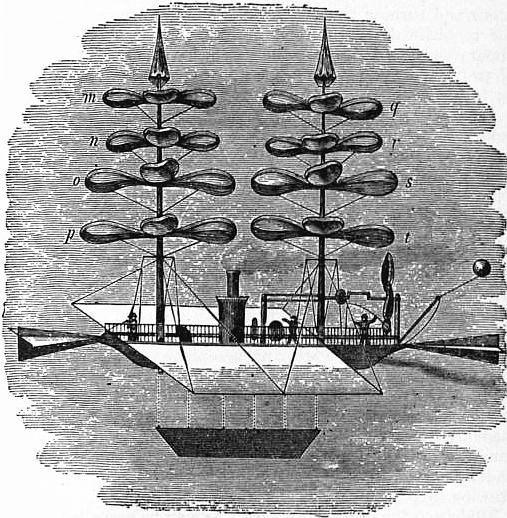 |
| Fig. 37.—De la Landelle’s Flying-machine. m, n, o, p; q, r, s, t, Screws arranged on vertical axes to act vertically upwards. The vertical axes are surmounted by two parachutes, and the body of the machine is furnished with an engine, propeller, rudders and an extensive aeroplane. |
Stimulated by the success of his spring models, Ponton d’Amécourt had a small steam model constructed. This model, which was shown at the exhibition of the Aeronautical Society of Great Britain at the Crystal Palace in 1868, consisted of two superposed screws propelled by an engine, the steam for which was generated (for lightness) in an aluminium boiler. This steam model proved a failure, inasmuch as it only lifted a third of its own weight. Fig. 37 embodies de la Landelle’s ideas.
All the models referred to (Cayley’s excepted17) were provided with rigid screws. In 1872 Pénaud discarded the rigid screws in favour of elastic ones, as Pettigrew had done some years before.
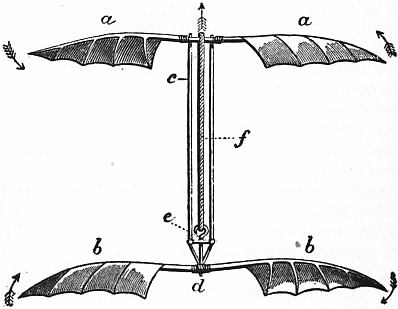 |
| Fig. 38.—Hélicoptère or Screw-Model, by Pénaud. |
Pénaud also substituted india-rubber under torsion for the whalebone and clock springs of the smaller models, and the steam of the larger ones. His hélicoptère or screw-model is remarkable for its lightness, simplicity and power. The accompanying sketch will serve to illustrate its construction (fig. 38). It consists of two superposed elastic screws (a a, b b), the upper of which (a a) is fixed in a vertical frame (c), which is pivoted in the central part (d) of the under screw. From the centre of the under screw an axle provided with a hook (e), which performs the part of a crank, projects in an upward direction. Between the hook or crank (e) and the centre of the upper screw (a a), the india-rubber in a state of torsion (f) extends. By fixing the lower screw and turning the upper one a sufficient number of times the requisite degree of torsion and power is obtained. The apparatus when liberated flies into the air sometimes to a height of 50 ft., and gyrates in large circles for a period varying from 15 to 30 seconds.
Pénaud next directed his attention to the construction of a model, to be propelled by a screw and sustained by an elastic aeroplane extending horizontally. Sir George Cayley proposed such a machine in 1810, and W.S. Henson constructed and patented a similar machine in 1842. Several inventors succeeded in making models fly by the aid of aeroplanes and screws, as, e.g. J. Stringfellow in 1847,18 and F. du Temple in 1857. These models flew in a haphazard sort of a way, it being found exceedingly difficult to confer on them the necessary degree of stability fore and aft and laterally. Pénaud succeeded in overcoming the difficulty in question by the invention of what he designated an automatic rudder. This consisted of a small elastic aeroplane placed aft or behind the principal aeroplane which is also elastic. The two elastic aeroplanes extended horizontally and made a slight upward angle with the horizon, the angle made by the smaller aeroplane (the rudder) being slightly in excess of that made by the larger. The motive power was india-rubber in the condition of torsion; the propeller, a screw. The reader will understand the arrangement by a reference to the accompanying drawing (fig. 39).
Models on the aeroplane screw type may be propelled by two screws, one fore and one aft, rotating in opposite directions; and in the event of only one screw being employed it may be placed in front of or behind the aeroplane.
When such a model is wound up and let go it descends about 2 ft., after which, having acquired initial velocity, it rises and flies in a forward direction at a height of from 8 to 10 ft. from the ground for a distance of from 120 to 130 ft. It flies this distance in from 10 to 11 seconds, its mean speed being something like 12 ft. per second. From experiments made with this model, Pénaud calculates that one horse-power would elevate and support 85 ℔
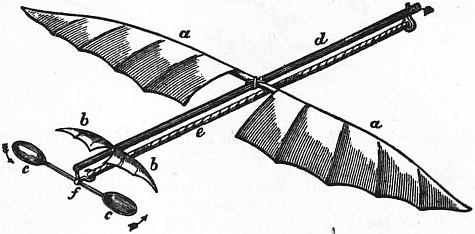 |
|
| Fig. 39.—Aeroplane Model with Automatic Rudder. | |
a a, Elastic aeroplane. b b, Automatic rudder. c c, Aerial screw centred at f. d, Frame supporting aeroplane, rudder and screw. |
e, India-rubber, in a state of torsion, attached to hook or crank at f. By holding the aeroplane (a a) and turning the screw (c c) the necessary power is obtained by torsion. (Pénaud.) |
D.S. Brown also wrote (1874) in support of elastic aero-biplanes. His experiments proved that two elastic aeroplanes united by a central shaft or shafts, and separated by a wide interval, always produce increased stability. The production of flight by the vertical flapping of wings is in some respects the most difficult, but this also has been attempted and achieved. Pénaud and A.H. de Villeneuve each constructed winged models. Marey was not so fortunate. He endeavoured to construct an artificial insect on the plan advocated by Borelli, Strauss-Dürckheim and Chabrier, but signally failed, his insect never having been able to lift more than a third of its own weight.
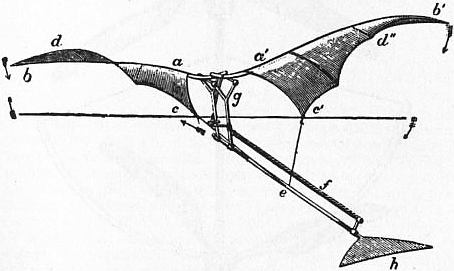 |
|
| Fig. 40.—Pénaud’s Artificial Flying Bird. | |
a b c d, a′ b′ c′ d′, Elastic wings, which twist and untwist when made to vibrate. a b, a′ b′, Anterior margins of wings. c d, c′ d′, Posterior margins of wings. c, c′, Inner portions of wings attached to central shaft of model by elastic bands at e. |
f, India-rubber in a state of torsion, which provides the motive power, by causing the crank situated between the vertical wing supports (g) to rotate; as the crank revolves the wings are made to vibrate by means of two rods which extend between the crank and the roots of the wings. h, Tail of artificial bird. |
De Villeneuve and Pénaud constructed their winged models on different types, the former selecting the bat, the latter the bird. De Villeneuve made the wings of his artificial bat conical in shape and comparatively rigid. He controlled the movements of the wings, and made them strike downwards and forwards in imitation of natural wings. His model possessed great power of rising. It elevated itself from the ground with ease, and flew in a horizontal direction for a distance of 24 ft., and at a velocity of 20 m. an hour. Pénaud’s model differed from de Villeneuve’s in being provided with elastic wings, the posterior margins of which in addition to being elastic were free to move round the anterior margins as round axes (see fig. 24). India-rubber springs were made to extend between the inner posterior parts of the wings and the frame, corresponding to the backbone of the bird.
A vertical movement having been communicated by means of india-rubber in a state of torsion to the roots of the wings, the wings themselves, in virtue of their elasticity, and because of the resistance experienced from the air, twisted and untwisted and formed reciprocating screws, precisely analogous to those originally described and figured by Pettigrew in 1867. Pénaud’s arrangement is shown in fig. 40.
If the left wing of Pénaud’s model (a b, c d of fig. 40) be compared with the wing of the bat (fig. 18), or with Pettigrew’s artificial wing (fig. 32), the identity of principle and application is at once apparent.
In Pénaud’s artificial bird the equilibrium is secured by the addition of a tail. The model cannot raise itself from the ground, but on being liberated from the hand it descends 2 ft. or so, when, having acquired initial velocity, it flies horizontally for a distance of 50 or more feet, and rises as it flies from 7 to 9 ft. The following are the measurements of the model in question:—length of wing from tip to tip, 32 in.; weight of wing, tail, frame, india-rubber, &c., 73 grammes (about 2½ ounces).
Flying Machines.—Henson’s flying machine, designed in 1843, was the earliest attempt at aviation on a great scale. Henson was one of the first to combine aerial screws with extensive supporting structures occupying a nearly horizontal position. The accompanying illustration explains the combination (fig. 41).
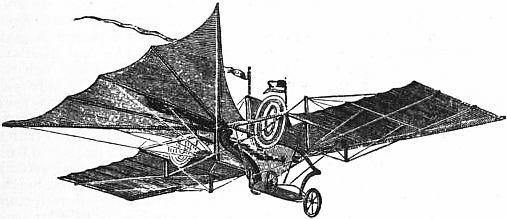 |
| Fig. 41.—Henson’s Aerostat. |
“The chief feature of the invention was the very great expanse of its sustaining planes, which were larger in proportion to the weight it had to carry than those of many birds. The machine advanced with its front edge a little raised, the effect of which was to present its under surface to the air over which it passed, the resistance of which, acting upon it like a strong wind on the sails of a windmill, prevented the descent of the machine and its burden. The sustaining of the whole, therefore, depended upon the speed at which it travelled through the air, and the angle at which its under surface impinged on the air in its front.... The machine, fully prepared for flight, was started from the top of an inclined plane, in descending which it attained a velocity necessary to sustain it in its further progress. That velocity would be gradually destroyed by the resistance of the air to the forward flight; it was, therefore, the office of the steam-engine and the vanes it actuated simply to repair the loss of velocity; it was made, therefore, only of the power and weight necessary for that small effect.” The editor of Newton’s Journal of Arts and Sciences speaks of it thus:—“The apparatus consists of a car containing the goods, passengers, engines, fuel, &c., to which a rectangular frame, made of wood or bamboo cane, and covered with canvas or oiled silk, is attached. This frame extends on either side of the car in a similar manner to the outstretched wings of a bird; but with this difference, that the frame is immovable. Behind the wings are two vertical fan wheels, furnished with oblique vanes, which are intended to propel the apparatus through the air. The rainbow-like circular wheels are the propellers, answering to the wheels of a steamboat, and acting upon the air after the manner of a windmill. These wheels receive motions from bands and pulleys from a steam or other engine contained in the car. To an axis at the stern of the car a triangular frame is attached, resembling the tail of a bird, which is also covered with canvas or oiled silk. This may be expanded or contracted at pleasure, and is moved up and down for the purpose of causing the machine to ascend or descend. Beneath the tail is a rudder for directing the course of the machine to the right or to the left; and to facilitate the steering a sail is stretched between two masts which rise from the car. The amount of canvas or oiled silk necessary for buoying up the machine is stated to be equal to one square foot for each half pound of weight.”
F.H. Wenham, thinking to improve upon Henson, invented in 1866 what he designated his aeroplanes.19 These were thin, light, long, narrow structures, arranged above each other in tiers like so many shelves. They were tied together at a slight upward angle, and combined strength and lightness. The idea was to obtain great sustaining area in comparatively small space with comparative ease of control. It was hoped that when the aeroplanes were wedged forward in the air by vertical screws, or by the body to be flown, each aeroplane would rest or float upon a stratum of undisturbed air, and that practically the aeroplanes would give the same support as if spread out horizontally. The accompanying figures illustrate Wenham’s views (figs. 42 and 43).
 |
|
| Fig. 42.—Wenham’s system of Aeroplanes designed to carry a man. | |
a, a, Thin planks, tapering at each end, and attached to a triangle. b, Similar plank for supporting the aeronaut. c, c, Thin bands of iron with truss planks a, a, and |
d, d, Vertical rods. Between these are stretched five bands of holland 15 in. broad and 16 ft. long, the total length of the web being 80 ft. This apparatus when caught by a gust of wind, actually lifted the aeronaut. |
 |
|
| Fig. 43.—A similar system, planned by Wenham. | |
a, a, Main spar 16 ft. long; b, b, Panels, with base board for aeronaut attached to main spar. |
e, e, Thin tie-band of steel with struts starting from main spar. This forms a strong light framework for the aeroplanes, consisting of six webs of thin holland 15 in. broad. The aeroplanes are kept in parallel plane by vertical divisions of holland 2 ft. wide. c, c′, Wing propellers driven by the feet. |
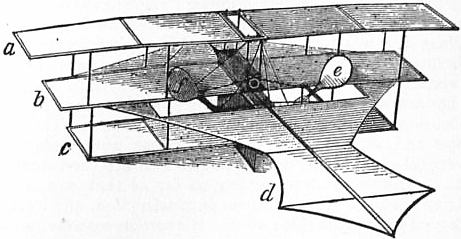 |
| Fig. 44.—Stringfellow’s Flying Machine. |
Stringfellow, who was originally associated with Henson, and built a successful flying model in 1847, made a second model in 1868, in which Wenham’s aeroplanes were combined with aerial screws. This model was on view at the exhibition of the Aeronautical Society of Great Britain, held at the Crystal Palace, London, in 1868. It was remarkably compact, elegant and light, and obtained the £100 prize of the exhibition for its engine, which was the lightest and most powerful so far constructed. The illustration below (fig. 44), drawn from a photograph, gives a very good idea of the arrangement—a, b, c representing the superimposed aeroplanes, d the tail, e, f the screw propellers. The superimposed aeroplanes (a, b, c) in this machine contained a sustaining area of 28 sq. ft., in addition to the tail (d). Its engine represented a third of a horse power, and the weight of the whole (engine, boiler, water, fuel, superimposed aeroplanes and propellers) was under 12 ℔ Its sustaining area, if that of the tail (d) be included, was something like 36 sq. ft., i.e. 3 sq. ft. for every pound. The model was forced by its propellers along a wire at a great speed, but so far as an observer could determine, failed to lift itself, notwithstanding its extreme lightness and the comparatively very great power employed. Stringfellow, however, stated that it occasionally left the wire and was sustained by its aeroplanes alone.
The aerial steamer of Thomas Moy (fig. 45), designed in 1874, consisted of a light, powerful, skeleton frame resting on three wheels; a very effective light engine constructed on a new principle, which dispensed with the old-fashioned, cumbrous boiler; two long, narrow, horizontal aeroplanes; and two comparatively very large aerial screws. The idea was to get up the initial velocity by a preliminary run on the ground. This accomplished it was hoped that the weight of the machine would gradually be thrown upon the aeroplanes in the same way that the weight of certain birds—the eagle, e.g.—is thrown upon the wings after a few hops and leaps. Once in the air the aeroplanes, it was believed, would become effective in proportion to the speed attained. The machine, however, did not realize the high expectations formed of it, and like all its predecessors it was doomed to failure.
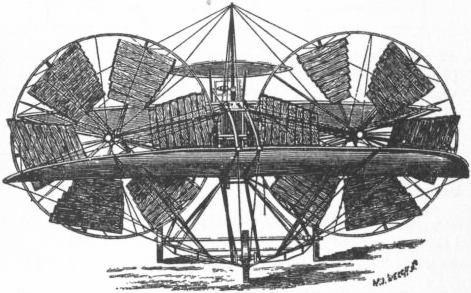 |
| Fig. 45.—Moy’s Aerial Steamer. |
Two of the most famous of the next attempts to solve the problem of artificial flight, by means of aeroplanes, were those of Prof. S.P. Langley and Sir Hiram S. Maxim, who began their aerial experiments about the same time (1889-1890). By 1893-1894 both had embodied their views in models and large flying machines.
Langley, who occupied the position of secretary to the Smithsonian Institution, Washington, U.S.A., made many small flying models and one large one. These he designated “aerodromes.” They were all constructed on a common principle, and were provided with extensive flying surfaces in the shape of rigid aeroplanes inclined at an upward angle to the horizon, and more or less fixed on the plan advocated by Henson. The cardinal idea was to force the aeroplanes (slightly elevated at their anterior margins) forwards, kite-fashion, by means of powerful vertical screw propellers driven at high speed—the greater the horizontal speed provided by the propellers, the greater, by implication, the lifting capacity of the aerodrome. The bodies, frames and aeroplanes of the aerodromes were strengthened by vertical and other supports, to which were attached aluminium wires to ensure absolute rigidity so far as that was possible. Langley aimed at great lightness of construction, and in this he succeeded to a remarkable extent. His aeroplanes were variously shaped, and were, as a rule, concavo-convex, the convex surface being directed upwards. He employed a competent staff of highly trained mechanics at the Smithsonian Institution, and great secrecy was observed as to his operations. He flew his smallest models in the great lecture room of the National Museum, and his larger ones on the Potomac river about 40 m. below Washington.
While Langley conducted his preliminary experiments in 1889, he did not construct and test his steam-driven flying models until 1893. These were made largely of steel and aluminium, and one of them in 1896 made the longest flight then recorded for a flying machine, namely, fully half a mile on the Potomac river. The largest aerodrome, intended to carry passengers and to be available for war purposes, was built to the order and at the expense of the American government, which granted a sum of fifty thousand dollars for its construction.
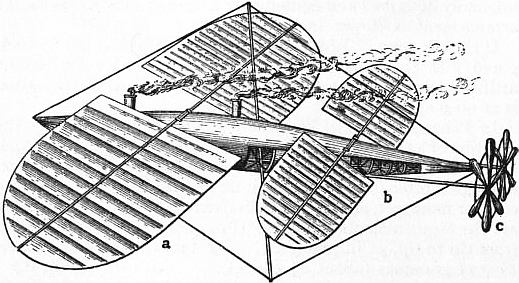 |
| Fig. 46.—Langley’s Flying Machine. a, Large aeroplane; b, Small aeroplane; c, Propelling screws. |
Langley’s machine shown in fig. 46 was a working model, not intended to carry passengers. In configuration the body-portion closely resembled a mackerel. The backbone was a light but very rigid tube of aluminium steel, 15 ft. in length, and a little more than 2 in. in diameter. The engines were located in the portion of the framework corresponding to the head of the fish; they weighed 60 oz. and developed one horse-power. There were four boilers made of thin hammered copper and weighing a little more than 7 ℔ each; these occupied the middle portion of the fish. The fuel used was refined gasoline, and the extreme end of the tail of the fish was utilized for a storage tank with a capacity of one quart. There were twin screw propellers, which could be adjusted to different angles in practice, to provide for steering, and made 1700 revolutions a minute. The wings, or aeroplanes, four in number, consisted of light frames of tubular aluminium steel covered with china silk. The pair in front were 42 in. wide and 40 ft. from tip to tip. They could be adjusted at different angles. The machine required to be dropped from a height, or a preliminary forward impetus had to be given to it, before it could be started. Fixity of all the parts was secured by a tubular mast extending upwards and downwards through about the middle of the craft, and from its extremities ran stays of aluminium wire to the tips of the aeroplanes and the end of the tubular backbone. By this trussing arrangement the whole structure was rendered exceedingly stiff.
 |
| Fig. 47.—Langley’s Aerodrome in flight. |
In the larger aerodrome (fig. 47) the aeroplanes were concavo-convex, narrow, greatly elongated and square at their free extremities, the two propellers, which were comparatively very large, being placed amidships, so to speak. At the first trial of this machine, on the 7th of October 1903, just as it left the launching track it was jerked violently down at the front (being caught, as subsequently appeared, by the falling ways), and under the full power of its engine was pulled into the water, carrying with it its engineer. When the aerodrome rose to the surface, it was found that while the front sustaining surfaces had been broken by their impact with the water, yet the rear ones were comparatively uninjured. At the second and last attempt, on the 8th of December 1903, another disaster, again due to the launching ways, occurred as the machine was leaving the track. This time the back part of the machine, in some way still unexplained, was caught by a portion of the launching car, which caused the rear sustaining surface to break, leaving the rear entirely without support and it came down almost vertically into the water. Darkness had come before the engineer, who had been in extreme danger, could aid in the recovery of the aerodrome. The boat and machine had drifted apart, and one of the tugs in its zeal to render assistance had fastened a rope to the frame of the machine in the reverse position from what it should have been attached, and had broken the frame entirely in two. Owing to lack of funds further trials were abandoned (see Annual Report of the Smithsonian Institution, 1904, p. 122).
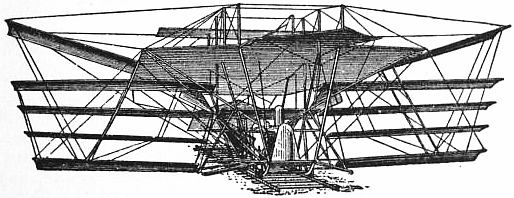 |
| Fig. 48.—Sir H. Maxim’s Flying Machine. |
Sir Hiram S. Maxim, like Langley, employed a staff of highly skilled workmen. His machine (fig. 48) consisted of a platform, on which stood a large water-tube boiler, a number of concavo-convex aeroplanes arranged in tiers like shelves, each making a slight upward angle with the horizon, two very large vertical screws placed aft and propelled by steam engines, tanks for the storage of water, naphtha, &c. The boiler was especially noteworthy. The water was contained in about 2000 bent copper tubes, only 3⁄8 in. in external diameter, heated by over 7000 gas jets arranged in rows. The fuel was naphtha or gasoline. Steam could be got up in the short space of half a minute. The steam-generating appliances, which weighed only 1000 ℔ in all, were placed in the front of the machine. The motive power was provided by a pair of two-cylinder, compound engines, poised about 8 ft. from the ground, and about 6 ft. apart. Each of them was independently governed, and furnished together 363 horse-power in actual effect, an amount which, considering that their total weight was only 600 ℔, gave the extraordinary efficiency of over 1 horse-power for every 2 ℔ weight. The high and the low pressure cylinders were 5 and 8 in. in diameter respectively, and the stroke was 12 in. When going at full speed these engines conferred 425 revolutions per minute on the two gigantic propellers that drove the machine along. These were in appearance like two-bladed marine propellers except that they were square instead of rounded at the ends, and were broad and thin. They were built from overlapping strips of American pine, planed smooth and covered with glued canvas. They weighed 135 ℔ each, the length of each blade being close upon 9 ft. and the width at the ends 5½ ft. The pitch was 16 ft. They were carefully stayed by steel wires to their shafts, or the first revolution would have snapped them off short. The material of which the framework was built was thin steel tubing, exceedingly light. All the wires and ties were of the best steel, capable of standing a strain of 100 tons to the square inch. The body of the machine was oblong in shape, with the fore-part cut away like a water-chute boat, and a long counter at the stern over which the propellers revolved. It had canvas stretched all over it. High overhead, like a gigantic awning, was the slightly concavo-convex main aeroplane, tilted towards the front at an imperceptible angle, and stretched taut. Its area was 1400 sq. ft., increased by side wings to 2700 sq. ft. There were also side aeroplanes arranged in tiers, and large aeroplanes in front, which were pivoted and served for vertical steering. The machine was strengthened in every direction by vertical and other supports and securely wired together at all points. It was furnished with four strong flanged wheels and ran along a light broad-gauge (9 ft.) railway track, 1800 ft. long, in the hope that when the speed reached a certain point it would leave the rails, but it was prevented from rising more than an inch or so by four arms, or outriggers, furnished with wheels, which projected from its sides and ran under an inverted wooden upper or safety track outside the railway track proper.
At a trial carried out in 1894 at Bexley, Kent, only the main aeroplane, the fore and aft rudders, and the top and bottom side planes were in position. After everything had been got in readiness, careful observers were stationed along the track, and the machine was connected to a dynamometer. The engines were then started and the pump set so as to deliver over 5000 ℔ of water per hour into the boiler. The gas was then carefully turned on until the pressure amounted to 310 ℔ per sq. in., and the dynamometer showed a thrust of more than 2100 ℔ A small safety-valve placed in the steam pipe had been adjusted so as to blow off slightly at 310 ℔ and with a strong blast at 320 ℔ The signal being given to let go, the machine darted forward at a terrific pace, and the safety-valve ceased to blow. More gas was instantly turned on, and before the machine had advanced 300 ft., the steam had mounted to 320 ℔ per sq. in., and the safety-valve was blowing off a steady blast. When the machine had travelled only a few hundred feet, all four of the small outrigger wheels were fully engaged, which showed that the machine was lifting at least 8000 ℔ The speed rapidly increased until when the machine had run about 900 ft. one of the rear axletrees, which were of 2 in. steel tubing, doubled up and set the rear end of the machine completely free. When the machine had travelled about 1000 ft., the left-hand forward wheel became disengaged from the safety track, and shortly after this the right-hand wheel broke the upper track—3 in. by 9 in. Georgia pine—and a plank became entangled in the framework of the machine. Steam had already been shut off, and the machine coming to rest fell directly to the ground, all four of its wheels sinking deeply into the turf without leaving other marks. Before making this run the wheels which were to engage the upper track were painted, and the paint left by them on the upper track indicated the exact point where the machine lifted. The area of the aeroplanes was very nearly 4000 sq. ft. and the total lifting effect was fully 10,000 ℔ The planes therefore lifted 2.5 ℔ per sq. ft., and 5 ℔ for each pound thrust. Nearly half of the power of the engines was lost in the screw slip. This showed that the diameter of the screws was not great enough; it should have been at least 22 ft.
In 1897 M.C. Ader, who had already tested, with indifferent results, two full-sized flying machines, built a third apparatus with funds furnished by the French government. This reproduced the structure of a bird with almost servile imitation, save that traction was obtained by two screw-propellers. The steam engine weighed about 7 ℔ per horse-power, but the equilibrium of the apparatus was defective.
Largely with the view of studying the problem of maintaining equilibrium, several experimenters, including Otto Lilienthal, Percy Pilcher and Octave Chanute, cultivated gliding flight by means of aeroplanes capable of sustaining a man. They depended mainly on the utilization of natural air currents, trusting for stability and balance to movements in their own bodies, or in portions of their machines which they could control. They threw themselves from natural or artificial elevations, or, facing the wind, they ran or were dragged forwards against it until they got under way and the wind caught hold of their aeroplanes. To Lilienthal in Germany belongs the double credit of demonstrating the superiority of arched over flat surfaces, and of reducing gliding flight to regular practice. He made over 2000 glides safely, using gravity as his motive power, with concave, batlike wings, in some cases with superposed surfaces (fig. 49). It was with a machine of the latter type that he was upset by a sudden gust of wind and killed in 1896. Pilcher in England improved somewhat on Lilienthal’s apparatus, but used the same general method of restoring the balance, when endangered, by shifting the weight of the operator’s body. He too made several hundred glides in safety, but finally was thrown over by a gust of wind and killed in 1899. Chanute in America confined his endeavours to the production of automatic stability, and made the surfaces movable instead of the man. He used several different forms of apparatus, including one with five superposed pairs of wings and a tail (fig. 50) and another with two continuous aeroplanes, one above the other (fig. 51). He made over 1000 glides without accident.
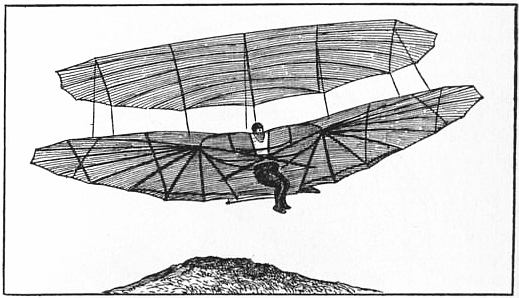 |
| Fig. 49.—Lilienthal’s Gliding Machine. |
Similar experiments were meanwhile conducted by Wilbur and Orville Wright of Dayton, Ohio, in whose hands the glider developed into a successful flying machine. These investigators began their work in 1900, and at an early stage introduced two characteristic features—a horizontal rudder in front for steering in the vertical plane, and the flexing or bending of the ends of the main supporting aeroplanes as a means of maintaining the structure in proper balance. Their machines to begin with were merely gliders, the operator lying upon them in a horizontal, position, but in 1903 a petrol motor was added, and a flight lasting 59 seconds was performed. In 1905 they made forty-five flights, in the longest of which they remained in the air for half an hour and covered a distance of 24½ m. The utmost secrecy, however, was maintained concerning their experiments, and in consequence their achievements were regarded at the time with doubt and suspicion, and it was hardly realized that their success would reach the point later achieved.
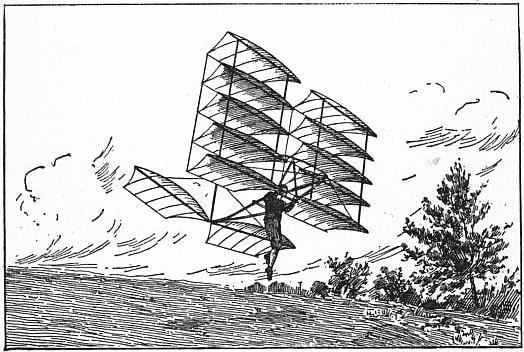 |
| Fig. 50.—Chanute’s Multiple Gliding Machine. |
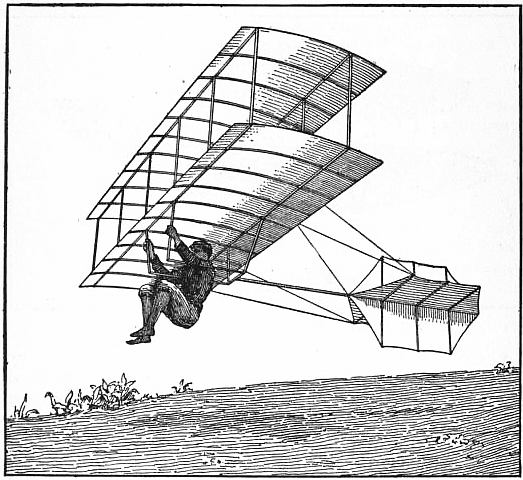 |
| Fig. 51.—Chanute’s Biplane Gliding Machine. |
Thanks, however, to the efforts of automobile engineers, great improvements were now being effected in the petrol engine, and, although the certainty and trustworthiness of its action still left something to be desired, it provided the designers of flying machines with what they had long been looking for—a motor very powerful in proportion to its weight. Largely in consequence of this progress, and partly no doubt owing to the stimulus given by the activity of builders of dirigible balloons, the construction of motor-driven aeroplanes began to attract a number of workers, especially in France. In 1906 A. Santos Dumont, after a number of successful experiments with dirigible cigar-shaped gas balloons, completed an aeroplane flying machine. It consisted of the following parts:—(a) A system of aeroplanes arranged like the capital letter T at a certain upward angle to the horizon and bearing a general resemblance to box kites; (b) a pair of very light propellers driven at a high speed; and (c) an exceedingly light and powerful petrol engine. The driver occupied a position in the centre of the arrangement, which is shown in fig. 52. The machine was furnished with two wheels and vertical supports which depended from the anterior parts of the aeroplanes and supported it when it touched the ground on either side. With this apparatus he traversed on the 12th of November 1906 a distance of 220 metres in 21 seconds.
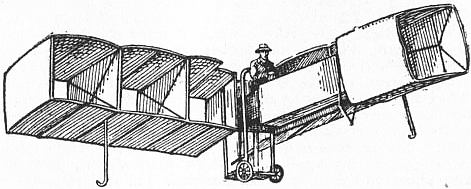 |
| Fig. 52.—Santos Dumont’s Flying Machine. |
About a year later Henry Farman made several short flights on a machine of the biplane type, consisting of two main supporting surfaces one above the other, with a box-shaped vertical rudder behind and two small balancing aeroplanes in front. The engine was an eight-cylinder Antoinette petrol motor, developing 49 horse-power at 1100 revolutions a minute, and driving directly a single metal screw propeller. On the 27th of October 1906 he flew a distance of nearly half a mile at Issy-les-Molineaux, and on the 13th of January 1908 he made a circular flight of one kilometre, thereby winning the Deutsch-Archdeacon prize of £2000. In March he remained in the air for 3½ minutes, covering a distance of 1¼ m.; but in the following month a rival, Leon Delagrange, using a machine of the same type and constructed by the same makers, Messrs Voisin, surpassed this performance by flying nearly 2½ m. in 6½ minutes. In July Farman remained in the air for over 20 minutes; on the 6th of September Delagrange increased the time to nearly 30 minutes, and on the 29th of the same month Farman again came in front with a flight lasting 42 minutes and extending over nearly 24½ m.
But the best results were obtained by the Wright brothers—Orville Wright in America and Wilbur Wright in France. On the 9th of September 1908 the former, at Fort Myer, Virginia, made three notable flights; in the first he remained in the air 57½ minutes and in the second 1 hour 3 minutes, while in the third he took with him a passenger and covered nearly 4 m. in 6 minutes. Three days later he made a flight of 45 m. in 1 hour 141⁄3 minutes, but on the 17th he had an accident, explained as being due to one of his propellers coming into contact with a stay, by which his machine was wrecked, he himself seriously injured, and Lieutenant Selfridge, who was with him, killed. Four days afterwards Wilbur Wright at Le Mans in France beat all previous records with a flight lasting 1 hour 31 minutes 254⁄5 seconds, in which he covered about 56 m.; and subsequently, on the 11th of October, he made a flight of 1 hour 9 minutes accompanied by a passenger. On the 31st of December he succeeded in remaining in the air for 2 hours 20 minutes 23 seconds.
Wilbur Wright’s machine (fig. 53), that used by his brother being essentially the same, consisted of two slightly arched supporting surfaces, each 12½ metres long, arranged parallel one above the other at a distance of 14⁄5 metres apart. As they were each about 2 metres wide their total area was about 50 sq. metres. About 3 metres in front of them was arranged a pair of smaller horizontal aeroplanes, shaped like a long narrow ellipse, which formed the rudder that effected changes of elevation, the driver being able by means of a lever to incline them up or down according as he desired to ascend or descend. The rudder for lateral steering was placed about 2½ metres behind the main surfaces and was formed of two vertical pivoted aeroplanes. The lever by which they were turned was connected with the device by which the ends of the main aeroplanes could be flexed simultaneously though in opposite directions; i.e. if the ends of the aeroplanes on one side were bent downwards, those on the other were bent upwards. By the aid of this arrangement the natural cant of the machine when making a turn could be checked, if it became excessive. The four-cylinder petrol engine was placed on the lower aeroplane a little to the right of the central line, being counterbalanced by the driver (and passenger if one was carried), who sat a little to the left of the same line. Making about 1200 revolutions a minute, it developed about 24 horse-power, and was connected by chain gearing to two wooden propellers, 2½ metres in diameter and 3½ metres apart, the speed of which was about 450 revolutions a minute. The whole machine, with aeronaut, weighed about 1100 ℔, the weight of the motor being reputed to be 200 ℔
Plate I.
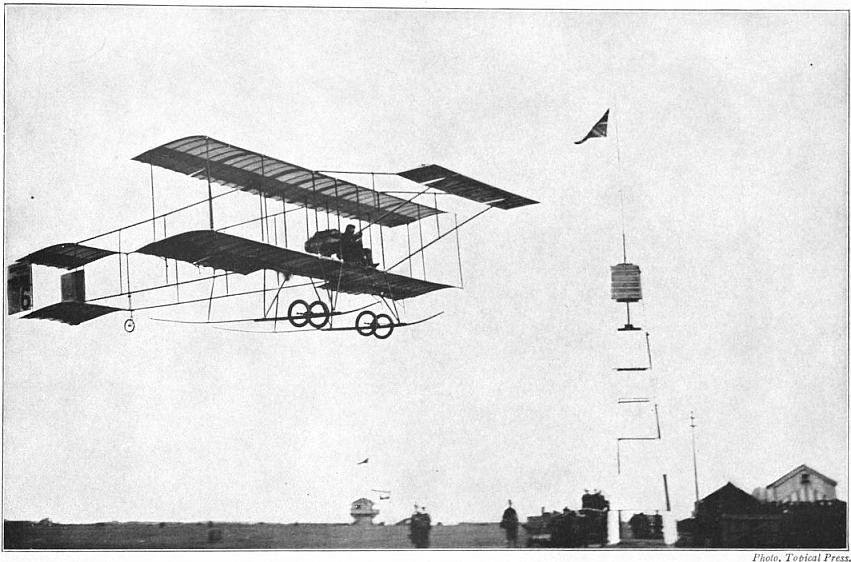 |
| Fig. 1.—PAULHAN FLYING ON FARMAN BIPLANE. |
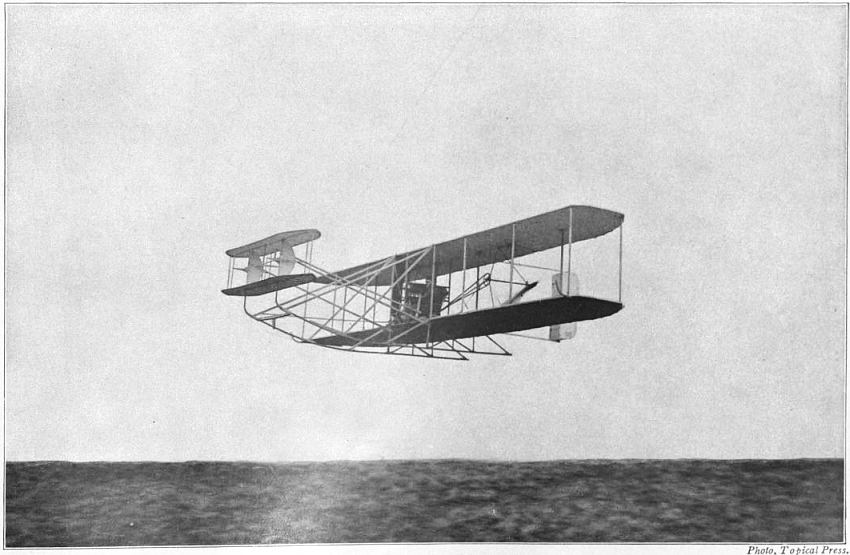 |
| Fig. 2.—WRIGHT BIPLANE. |
Plate II.
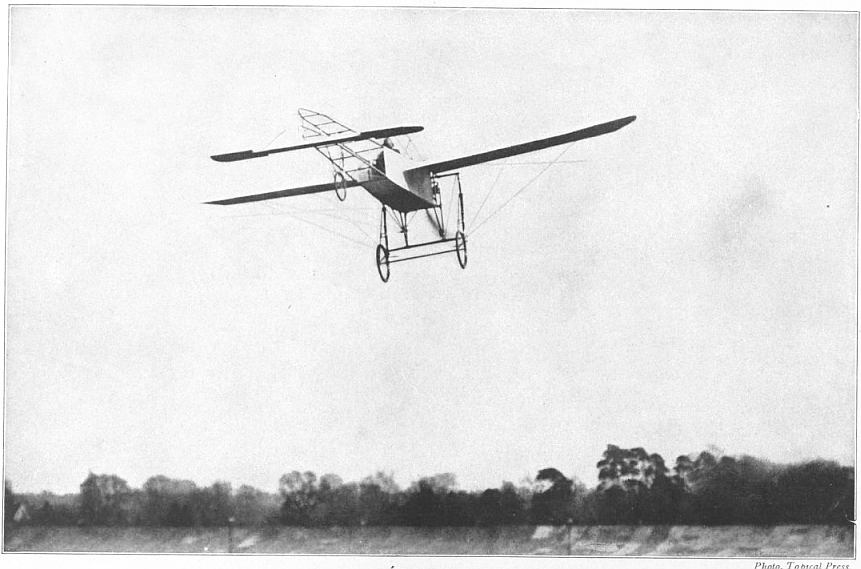 |
| Fig. 3.—BLERIOT MONOPLANE. |
 |
| Fig. 4.—A.V. ROE’S TRIPLANE. |
 |
|
| Fig. 53.—Wright Flying Machine; diagrammatic sketch. | |
A, B, Main supporting surfaces. C, D, Aeroplanes of horizontal rudder with fixed semilunar fin E. |
F, Vertical rudder. G, Motor. H, Screws. |
A feature of the year 1909 was the success obtained with monoplanes having only a single supporting surface, and it was on a machine of this type that the Frenchman Blériot on July 25th flew across the English Channel from Calais to Dover in 31 minutes. Hubert Latham all but performed the same feat on an Antoinette monoplane. The year saw considerable increases in the periods for which aviators were able to remain in the air, and Roger Sommer’s flight of nearly 2½ hours on August 7th was surpassed by Henry Farman on November 3rd, when he covered a distance estimated at 137¼ m. in 4 hr. 17 min. 53 sec. In both these cases biplanes were employed. Successful aviation meetings were held, among other places, at Reims, Juvisy, Doncaster and Blackpool; and at Blackpool a daring flight was made in a wind of 40 m. an hour by Latham. This aviator also proved the possibility of flying at considerable altitudes by attaining on December 1st a height of over 1500 ft., but this record was far surpassed in the following January by L. Paulhan, who on a biplane rose to a height of 1383 yds. at Los Angeles. In the course of the year three aviators were killed—Lefèvbre and Ferber in September and Fernandez in December; and four men perished in September by the destruction of the French airship “République,” the gas-bag of which was ripped open by a broken propeller. In January 1910 Delagrange was killed by the fracture of one of the wings of a monoplane on which he was flying. On April 27th-28th, 1910, Paulhan successfully flew from London to Manchester, with only one stop, within 24 hours, for the Daily Mail’s £10,000 prize.
The progress made by all these experiments at aviation had naturally created widespread interest, both as a matter of sport and also as indicating a new departure in the possibilities of machines of war. And in 1909 the British government appointed a scientific committee, with Lord Rayleigh as chairman, as a consultative body for furthering the development of the science in England.
The table below gives some details, approximately correct, of the principal experiments made with flying machines up to 1908.
| Year. | Experimenter. | Tip to Tip. |
Surface. | Weight. | Pounds per sq. ft. |
Speed per hour. |
Maximum Flight. |
Motor. | Horse- power. |
Pounds sustained per h.p. |
| Ft. | Sq. ft. | ℔ | Mls. | Ft. | ||||||
| 1879 | Tatin | 6.2 | 7.5 | 3.85 | 0.51 | 18 | 100? | Compressed air |
0.03 | 110? |
| 1885 1889 |
Hargrave (No. 16) | 5.5 | 26.0 | 5.00 | 0.19 | 10 | 343 | ” | 0.06 | 79 |
| 1893 | Phillips | 22.0 | 136.0 | 402.00 | 3.00 | 28 | 500? | Steam | 5.6 | 72? |
| 1894 | Maxim* | 50.0 | 4000.0 | 8000.00 | 2.5 | 36 | 300? | ” | 363.00 | 28 |
| 1896 | Langley | 12.0 | 70.0 | 30.00 | 0.43 | 24 | 4,000 | ” | 1.00 | 30 |
| 1897 | Tatin and Richet | 21.0 | 86.0 | 72.00 | 0.83 | 40 | 460 | ” | 1.33 | 55 |
| 1897 | Ader* | 49.0 | 270.0 | 1100.00 | 4.00 | 50? | 100? | ” | 40.00 | 27 |
| 1895 | Lilienthal* | 23.0 | 151.0 | 220.00 | 1.46 | 23 | 1,200 | Gravity | 2.00 | 110 |
| 1896 | Pilcher* | 23.0 | 170.0 | 200.00 | 1.17 | 25 | 900 | ” | 2.00 | 100 |
| 1896 | Chanute* | 16.0 | 135.0 | 178.00 | 1.31 | 22 | 360 | ” | 2.00 | 89 |
| 1906 | S. Dumont* | 39 | 560 | 550 | 0.98 | 22.26 | 2,900 | Petrol | 50 | 23 |
| 1908 | W. Wright* | 41 | 650 | 1100 | 1.7 | 37 | 295,000 | Petrol | 24 | 46 |
| * The apparatus marked thus * carried a man or men. | ||||||||||
References.—Some of the books mentioned under Aeronautics contain details of flying machines; see H.W.L. Moedebeck, A Pocketbook of Aeronautics, trans. by W. Mansergh Varley (London, 1907); Sir Hiram S. Maxim, Artificial and Natural Flight (London, 1908); F.W. Lanchester, Aerodynamics and Aerodonetics (London, 1907 and 1908); C.C. Turner, Aerial Navigation of To-day (London, 1909); also two papers on “Aerial Navigation” read by Colonel G.O. Fullerton before the Royal United Service Institution in 1892 and 1906; papers read by Major B.F.S. Baden-Powell and E.S. Bruce before the Society of Arts, London, in April 1907 and December 1908 respectively; Cantor Lectures by F.W. Lanchester (Society of Arts, 1909); and the Proceedings of the Aeronautical Society (founded 1865), &c.
1 According to Dr Crisp, the swallow, martin, snipe and many birds of passage have no air in their bones.—Proc. Zool. Soc. Lond. part xxv., 1857, p. 13.
2 By the term aeroplane is meant a thin, light, expanded structure inclined at a slight upward angle to the horizon intended to float or rest upon the air, and calculated to afford a certain amount of support to any body attached to it.
3 “On the Various Modes of Flight in relation to Aeronautics,” by J. Bell Pettigrew, Proc. Roy. Inst., 1867; “On the Mechanical Appliances by which Flight is attained in the Animal Kingdom,” by the same author, Trans. Linn. Soc., 1867.
4 Revue des cours scientifiques de la France et de l’Étranger, 1869.
5 The sphygmograph, as its name indicates, is a recording instrument. It consists of a smoked cylinder revolving by means of clock-work at a known speed, and a style or pen which inscribes its surface by scratching or brushing away the lampblack. The movements to be registered are transferred to the style or pen by one or more levers, and the pen in turn transfers them to the cylinder, where they appear as legible tracings. In registering the movements of the wings the tips and margins of the pinions were, by an ingenious modification, employed as the styles or pens. By this arrangement the different parts of the wings were made actually to record their own movements. As will be seen from this account, the figure-of-8 or wave theory of stationary and progressive flight has been made the subject of a rigorous experimentum crucis.
6 This continuity of the down into the up stroke and the converse is greatly facilitated by the elastic ligaments at the root and in the substance of the wing. These assist in elevating, and, when necessary, in flexing and elevating it. They counteract in some measure what may be regarded as the dead weight of the wing, and are especially useful in giving it continuous play.
7 “The importance of the twisted configuration or screw-like form cannot be over-estimated. That this shape is intimately associated with flight is apparent from the fact that the rowing feathers of the wing of the bird are every one of them distinctly spiral in their nature; in fact, one entire rowing feather is equivalent—morphologically and physiologically—to one entire insect wing. In the wing of the martin, where the bones of the pinion are short, and in some respects rudimentary, the primary and secondary feathers are greatly developed, and banked up in such a manner that the wing as a whole presents the same curves as those displayed by the insect’s wing, or by the wing of the eagle, where the bones, muscles and feathers have attained a maximum development. The conformation of the wing is such that it presents a waved appearance in every direction—the waves running longitudinally, transversely and obliquely. The greater portion of the wing may consequently be removed without essentially altering either its form or its functions. This is proved by making sections in various directions, and by finding that in some instances as much as two-thirds of the wing may be lopped off without materially impairing the power of flight.”—Trans. Roy. Soc. Edin. vol. xxvi. pp. 325, 326.
8 “On the Various Modes of Flight in relation to Aeronautics,” Proc. Roy. Inst., 1867; “On the Mechanical Appliances by which Flight is attained in the Animal Kingdom,” Trans. Linn. Soc., 1867, 26.
9 “On the Physiology of Wings; being an analysis of the movements by which flight is produced in the Insect, Bat and Bird,” Trans. Roy. Soc. Edin. vol. 26.
10 The other forces which assist in elevating the wings are—(a) the elevator muscles of the wings, (b) the elastic properties of the wings, and (c) the reaction of the compressed air on the under surfaces of the wings.
11 The wings of the albatross, when fully extended, measure across the back some 14 ft. They are exceedingly narrow, being sometimes under a foot in width.
12 On the Flight of Birds, of Bats and of Insects, in reference to the subject of Aerial Locomotion, by L. de Lucy (Paris).
13 E.J. Marey, Revue des cours scientifiques de la France et de l’étranger (1869).
14 “The Aero-bi-plane, or First Steps to Flight,” Ninth Annual Report of the Aeronautical Society of Great Britain, 1874.
15 “Resistance to Falling Planes on a Path of Translation,” Ninth Annual Report of the Aeronautical Society of Great Britain, 1874.
16 The Aeronaut for January 1872 and February 1875.
17 Cayley’s screws, as explained, were made of feathers, and consequently elastic. As, however, no allusion is made in his writings to the superior advantages possessed by elastic over rigid screws, it is to be presumed that feathers were employed simply for convenience and lightness. Pettigrew, there is reason to believe, was the first to advocate the employment of elastic screws for aerial purposes.
18 Stringfellow constructed a second model, which is described and figured further on (fig. 44).
19 “On Aerial Locomotion,” Aeronautical Society’s Report for 1867.


